NOTE: For prior parts in the Hizballah Cavalcade series you can view an archive of it all here.
—
Al-Quwat al-Ja’afariyah & Liwa al-Sayyida Ruqayya: The Building of an “Islamic Resistance” in Syria
By Phillip Smyth
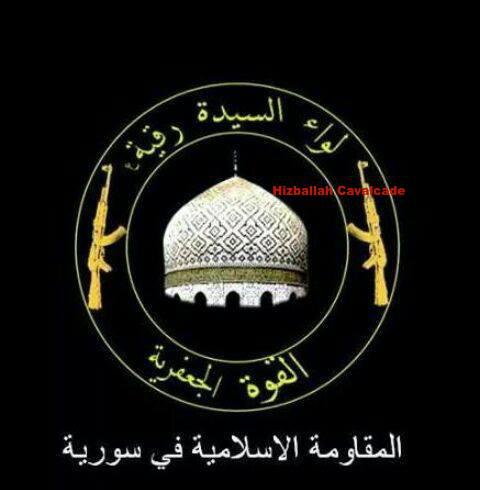
Figure 1: The logo belonging to Al-Quwat al-Ja’afariyah’s Liwa al-Sayyida Ruqayyah. The symbol features two golden Kalashnikov-type rifles flanking the white dome of the Sayyida Ruqayyah shrine. The group’s logo bears many similarities to Kata’ib Sayyid al-Shuahda’s. Both feature a shrine dome in the center of a roundel flanked by Kalashnikov-type rifles.
Since the creation of Syria’s pro-Assad National Defense Forces (NDF), there has been a rise in Syria-based sectarian militia groups with Iranian training and advisors. Al-Quwat al-Ja’afariyah (The Ja’afari Force) has attempted to market itself as one of these types of organizations. The group has also described itself as “al-muqawama al-islamiyah fi suriya” (“The Islamic Resistance in Syria”) and has pushed its own Shia identity mixed with pro-Assad Syrian nationalist and pro-Iranian proxy material. These elements of group identity suggest the militia pulls members from Syria’s small Shia community while still being influenced by external allied actors.
A process where local pro-Assad militias have been modeled off of Lebanese Hizballah has been a continuing development. This has especially been the case with Alawite-manned and Shia-manned militias. Syria’s first major Shia militia, Liwa Abu Fadl al-Abbas (LAFA) maintained close links to the Assad regime and Lebanese Hizballah. Even with Lebanese Hizballah’s aid, local actors such as LAFA’s secretary general, Abu Ajeeb, generally led LAFA’s command and control functions.
Unlike many of the other groups which have also worked closely with Lebanese Hizballah, Al-Quwat al-Ja’afariyah has also claimed to be a Syria-based subdivision belonging to the Iraqi Shia Iran-proxy, Kata’ib Sayyid al-Shuhada (KSS).
A number of Syria-based Shia militias have their own Iraqi wings and some Iraqi Shia political parties have external branches. Nonetheless, Al-Quwat al-Ja’afariyah is the only Syrian Shia militia which has declared itself as a sub-division of an Iraq-based Iraqi Shia Islamist group, yet began life as a component of an established Assad element (the NDF).
The first prominent mentions of Al-Quwat al-Ja’afariyah or its professed sub-militia Liwa al-Sayyida Ruqayya came with the April 6, 2013 death of NDF leader Shaker Rashid Darwish (A.K.A. Al-Ja’afari). Despite the group being around for a number of years, it lacked a formal announcement or acknowledgement outside of a small number of accounts on social media. At different times throughout 2014, the group’s members would often pose for photos in their battle dress uniforms. These photos regularly found their way onto mediums such as Facebook and could only be accessed via private Facebook profiles.
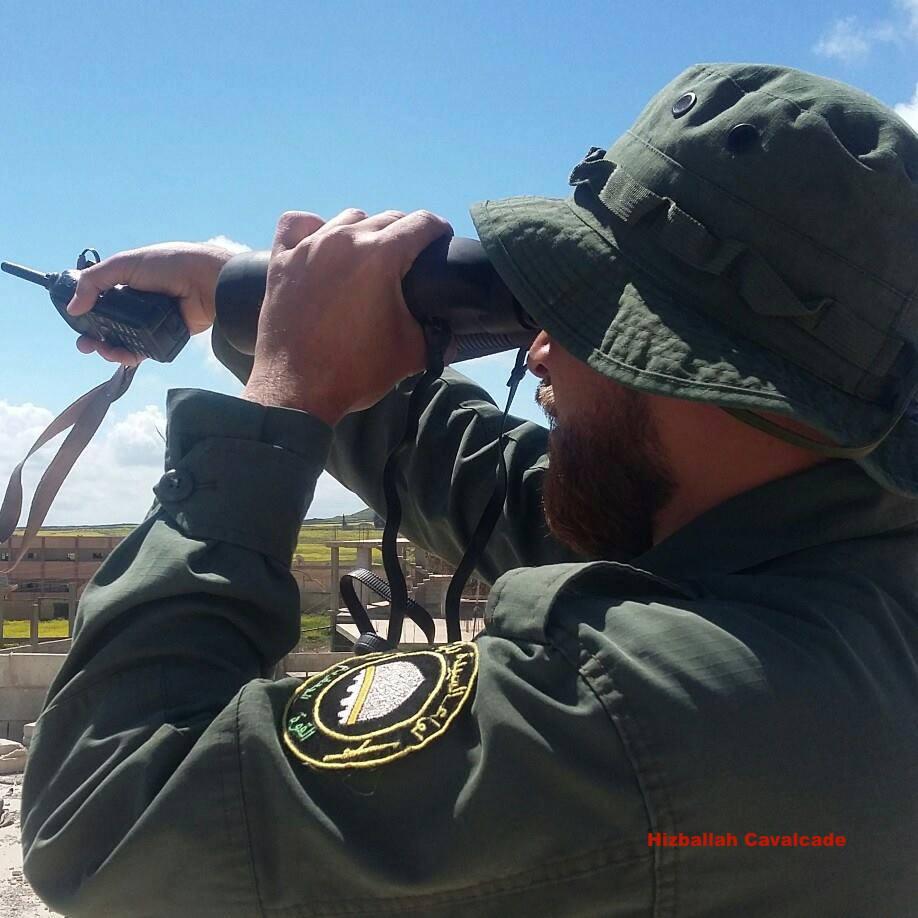
Figure 2: A militiaman belonging to Liwa al-Saqiyah Ruqayya wearing the group’s distinctive patch.
What set these photos aside from other uploaded images of Syrian and Iraqi Shia militiamen in Syria was that these fighters’ uniforms would feature unique patches. This patch included the group’s name along with a stylized version of the white dome of the Sayyida Ruqayya shrine in Damascus, Syria.
By late August 2015, due to an increased public presence by Al-Quwat al-Ja’afariyah on social media (via KSS’s own media apparatuses), and due to the death of Quwat al-Ja’afariyah commander Hasan Kana’an, more attention was granted by Arabic-language (primarily pro-Syrian rebel) media sources. In early July, Liwa al-Sayyida Ruqayya established a number of public Facebook pages and was also mentioned in a September 2015 piece by The Guardian (albeit, the group was incorrectly recognized as the “Sayyida Ruqayya Martyrs Brigade”).
What’s In A Name?
The term, “Ja’afari”, helps highlight Al-Quwat al-Ja’afariyah’s denominational membership. “Ja’afari” is often used as a synonym for “Shia Muslim”. Moreover, in the Twelver Shia tradition, Ja’afar al-Sadiq is considered the sixth and longest serving Imam. The majority of Shia Muslims also adhere to the Ja’afari school of jurisprudence.
Liwa Sayyida Ruqayya gets its name from the Sayyida Ruqayya mosque and shrine. Located in Old Damascus, the Sayyida Ruqayya mosque and shrine houses the remains of Sukayna (a.k.a. Ruqayya), the baby daughter of Twelver Shia Islam’s third Imam, Husayn ibn Ali.
Built in 1985 with Iranian funds, the design of the mosque was described by Iran analyst Nigel Coulthard as, “a pure example of post-revolutionary Iranian architecture that would have been more at home in Tehran than Damascus”. Sociology professor Marnia Lazreg claimed a Syrian policeman told her that the mosque, “was controlled by the Iranian government, which claimed its spiritual ownership.” Design and theological/political control aside, the shrine is one of Syria’s major Shia shrines.
Liwa al-Sayyida Ruqayya & The Militia’s Stages of Development
The main militia falling under the header of Al-Quwat al-Ja’afariyah is Liwa al-Sayyida Ruqayya (The Brigade of Sayyida Ruqayya). At the time of this writing, no other groups have yet been listed as under Quwat al-Ja’afariyah’s umbrella. The continual grouping of these two elements suggests that the groups may be one in the same, as opposed to it being a legitimate sub-militia which reports to a larger umbrella-style grouping or a parent organization.
Liwa al-Sayyida Ruqayya has claimed to be active in the Midan section of southern Damascus and to have fought in Jobar, Otaiba, Dekhania, and other sections to the north and east of Damascus. The group was also deployed to Shaykh Miskin in southern Syria.
Family connections between the group’s members is another noticeable trend. This speaks to how recruitment seeks new members and also shows the limited numbers from which it can recruit. During the militia’s participation in the November 2013 battles around Otaiba, Ali Mahmoud Darwish (A.K.A. Karar) and the 16 year-old fighter, Jawad Abbas Darwish (A.K.A. Abu Turab), were both killed. Reportedly, these fighters were cousins and were likely related to Shaker Rashid Darwish.

Figure 3: The Liwa al-Sayyida Ruqayya martyrdom poster for Hasan Ahmed Kana’an. He is listed as a “martyr commander”. Additionally, Liwa al-Sayyida al-Ruqayya is described as, “The Islamic Resistance in Syria”. Interestingly, despite the group’s links to Irqi KSS, on this poster the “Islamic Resistance in Syria and Lebanon” is mentioned and not the“Islamic Resistance in Iraq”.
There were number of developmental stages for the current Quwat al-Ja’afariyah and Liwa al-Sayyida Ruqayya. The first began with its inception as an NDF sub-militia in 2013. Then, the group’s fighters appeared under a number of different monikers. These names included, Huras al-Sayyida Ruqayya (The Guardians of Sayyida Ruqayya) and Liwa Ansar al-Husayn (The Brigade of the Supporters of Husayn). Whether these groups are still in existence, were little more than temporary fronts, or are elements of other units is unknown.
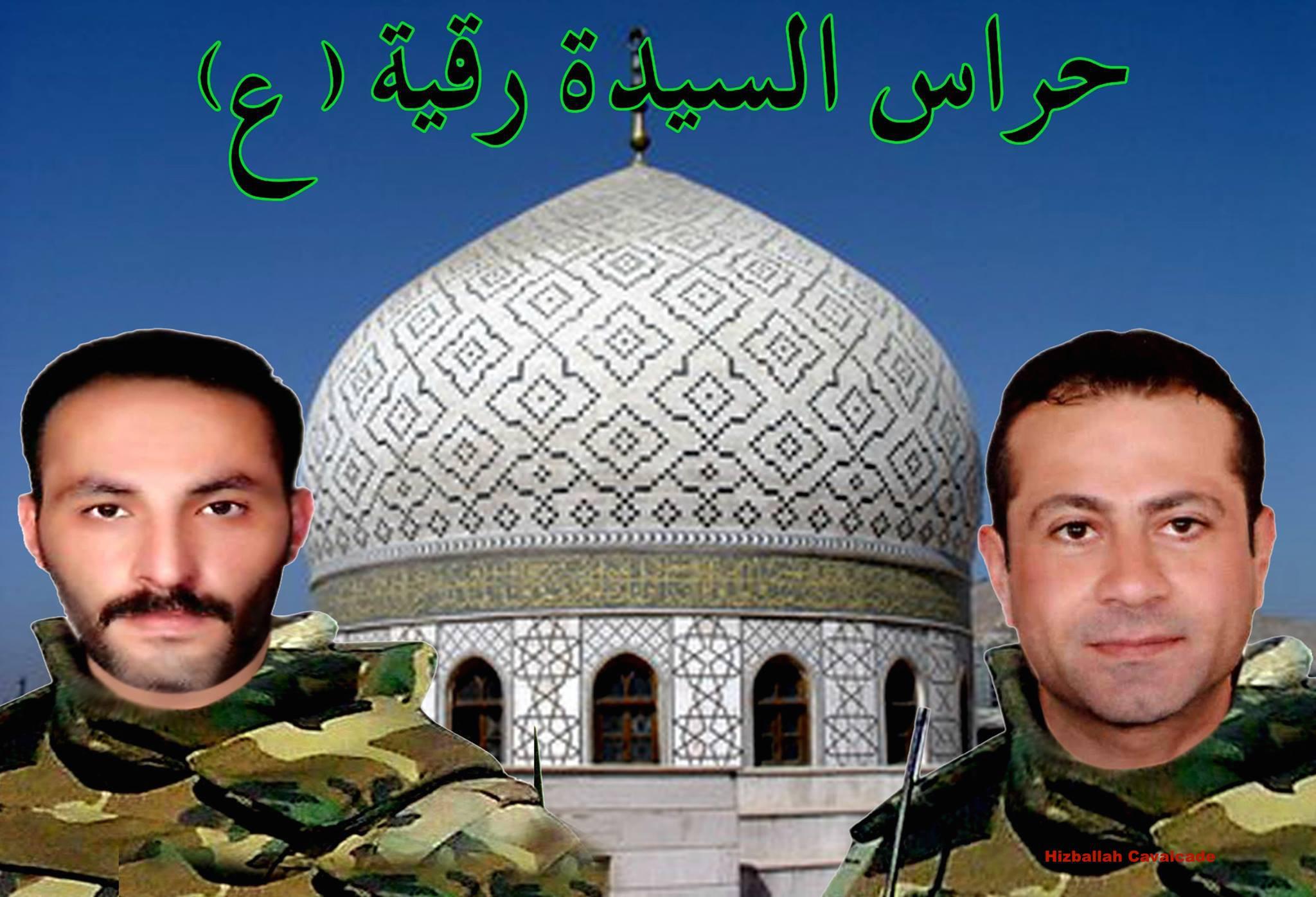
Figure 4: A “martyrdom” poster featuring killed Liwa al-Sayyida Ruqayya members under the header, “Huras al-Sayyida Ruqayya”.
Still, during this initial stage, there was more direct linkages to the NDF and the Assad regime. Images promoting pro-Assad Syrian nationalism were a regular feature. The second stage of development, which immediately followed (if not coincided with the first), was the addition of links to Lebanese Hizballah. “Martyrdom”
Category: Hizballah Cavalcade
Hizballah Cavalcade: The Big Picture Behind Kata’ib Hizballah’s Surface-to-Air Missile (SAM) Threats
NOTE: For prior parts in the Hizballah Cavalcade series you can view an archive of it all here.
—
The Big Picture Behind Kata’ib Hizballah’s Surface-to-Air Missile (SAM) Threats
By Phillip Smyth
First appearing on March 15, 2014 and posted to social media accounts linked to Kata’ib Hizballah (these included simultaneous posts on Facebook and Youtube)1, a video showing what appeared to be SA-7-type and SA-18-type Man-Portable Air-Defense System (MANPADS) was shown in the hands of Kata’ib Hizballah militiamen.
Interestingly, sections of one of the MANPADS serial numbers were also exposed in the video clip. It is possible the missile systems were not SA-7 and SA-18s, but might actually be an Iranian produced Misagh-type or Chinese produced QW-1-type MANPAD.2 This would not be the first time Kata’ib Hizballah has shown off a MANPAD capability. In 2010, the group released a video showing it possibly launching a QW-1-type missile system.
Technical details on what type of missile system was deployed aside, the video serves as a cap on a developing narrative line which has been promoted by Iran’s Shia militia proxies and via some Tehran’s own media organs.
Claims emanating from Iranian and their other proxy Shia militias have stated that the U.S. and other Coalition allies have supplied the so-called “Islamic State” (ISIS) via aerial deliveries. This was particularly the case in the month of February, during the run-up to the predominantly Shia militia push on Tikrit.3
As early as February 7, 2015, Kata’ib Hizballah statements were repeated in Iranian media. One report claimed the group had confirmed the U.S. was supplying ISIS via helicopter.4 Other accusations by Kata’ib Hizballah of U.S. supplies being routed to ISIS were continued. On February 20, a flurry of stories hit the media. Al-Etejah TV published a report that alleged that U.S. helicopter landed near the home of Sheikh Qasim al-Janabi.5 Janabi, a moderate Sunni tribal leader who worked with the Iraqi government was kidnapped and assassinated in Baghdad on February 14th.6 Janabi’s son and other moderate Sunni parliamentarians blamed Shia militias for his kidnapping and murder.7 Also on the 20th, Al-Etejah published a story citing representatives in Babil who claimed U.S. aircraft were dropping supplies to ISIS.8 Other outlets also published that Kata’ib Hizballah had threatened to deploy anti-aircraft missile systems in the wake of these claims that the U.S. was supplying ISIS.9
Three days later, the Badr Organization-linked Al Ghadeer TV reported that forces of the Hashd al-Sha’abi (Popular Mobilization, a term used to describe the umbrella grouping of numerous Iranian-backed and other local Shia militia forces) claimed to have recorded landings in Babil Province.10 This also coincided with even more baseless claims distributed via the IRGC-linked Fars News that two British planes had been “shot down” while carrying weapons to ISIS.11
These types of accusations continued, and on March 5, 2015, the head of the Badr Organization’s parliamentary bloc, Qasim Muhammed Jalal Hussein Al-Araji,12 stated that the group had documents proving the U.S. was aiding ISIS.13 In an article published a day after the Kata’ib Hizballah video release, Harakat Hizballah al-Nujaba leader, Akram Ka’abi threatened U.S.-led Coalition aircraft. In the interview he stated, “Our air defenses are ready to target their planes, which are helping IS by giving them weapons and ammunition.”14
What Does It All Mean?
Needless to say, an active campaign by Kata’ib Hizballah and other Iranian-backed Iraqi Shia militia/jihadist organizations has been aimed at the U.S. and other Coalition allies (namely, the U.K.). The display of MANPAD systems underlines what likely appears to be messaging aimed at reducing the Coalition’s willingness to undertake further anti-ISIS air operations. In turn, if the threats succeed in that goal, it would grant more responsibility and control for Iran and its proxies on the battlefields of Iraq.
Another, more ideologically based goal is also included within these threats. The claim that the U.S. and other Western entities have supported radical Sunni extremist groups is a theme well honed by Iran and its proxies since the U.S. occupied Iraq (2003-2011) and in the war in Syria.15 The further push for these lines demonstrates another longer-term type of goal, even if it is only marginally effective, to alter the narrative and build broader distrust for the U.S. and other Western states.
1 Kata’ib Hizballah, an Iraq-based, direct Iranian proxy, was registered by the U.S. State Department as a Foreign Terrorist Organization in 2009: https://www.state.gov/r/pa/prs/ps/2009/july/125582.htm.
2 See: https://blogs-cdn.fas.org/wp-content/uploads/2013/10/The_MANPADS_Threat.pdf.
Note: Adam Rawnsley published a very comprehensive analysis of Kata’ib Hizballah’s MANPAD capabilities: https://medium.com/war-is-boring/iran-backed-terror-group-parades-new-anti-aircraft-missiles-in-iraq-ca0204079eb0 in the piece, Rawnsley assessed that one of the missile systems shown was a Chinese QW-1M.
3 See: https://www.cbsnews.com/news/isis-iraq-iran-shiite-militias-tikrit-questions-about-mosul/.
4 See: https://www.alalam.ir/news/1674215.
5 See: https://aletejahtv.org/index.php/permalink/47550.html.
6 See: https://www.wsj.com/articles/leading-iraqi-sunni-tribal-sheik-killed-1423951260.
7 Note: It is possible that Kata’ib Hizballah was attempting to craft another anti-U.S. conspiracy theory (or theories) with the inclusion Janabi in their reportage.
See: https://www.washingtonpost.com/world/sunni-parties-consider-leaving-iraqi-parliament-after-slaying-of-sheik/2015/02/14/7e164a8c-b463-11e4-bf39-5560f3918d4b_story.html.
8 See: https://aletejahtv.org/index.php/permalink/47558.html.
9 See: https://www.alsumaria.tv/news/125515/كتائب-حزب-الله-سننشر-صواريخ-مضادة-للطائر/ar.
10 See: https://alghadeer.tv/news/detail/23789/.
11 See: https://english.farsnews.com/newstext.aspx?nn=13931204001534.
12 See: https://www.iraqiparliament.info/en/node/673.
13 See: https://almasalah.com/ar/news/48777/%D8%A8%D8%AF%D8%B1–%D8%A7%D8%AF%D9%84%D8%A9-%D8%AA%D8%AB%D8%A8%D8%AA-%D9%85%D8%B3%D8%A7%D8%B9%D8%AF%D8%A9-%D8%A7%D9%85%D8%B1%D9%8A%D9%83%D8%A7-%D9%84%D8%AF%D8%A7%D8%B9%D8%B4.
14 See: https://www.al-monitor.com/pulse/originals/2015/03/iraq-shiite-hezbollah-nujaba-victory-islamic-state.html#.
15 In my monograph, “The Shiite Jihad In Syria and Its Regional Effects,” I outlined the ideological roots for claiming that Western states backed ISIS and other radical Sunni extremist elements. See: https://bit.ly/ShiiteJihadPDF. See the section marked, “Takfiris: A Perfect Enemy.”
Check out Phillip Smyth's new Policy Focus for The Washington Institute: "The Shiite Jihad in Syria and Its Regional Effects"
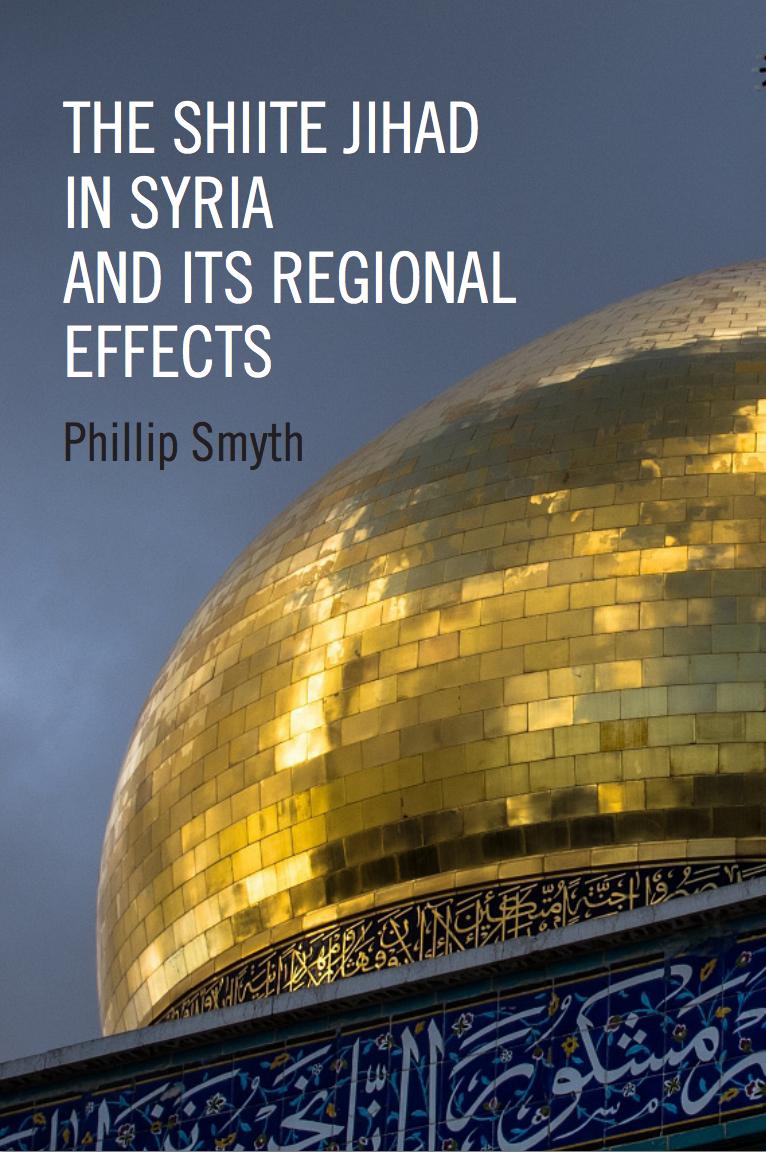
In 2012 and early 2013, media sources were widely reporting the imminent fall of Syria’s Bashar al-Assad regime to Sunni rebel groups. But not long thereafter, it began to show resilience, holding off further rebel advances and even retaking lost ground.
This turnabout was fueled largely by Iran-backed Shiite proxy groups fighting on Assad’s behalf. While these groups often invoked the defense of the Sayyeda Zainab shrine as their rallying cry, their influx into Syria was far from a spontaneous expression of Shiite unity. Indeed, it reflected instead a highly organized geostrategic and ideological effort by Iran to protect its Syrian ally and project power across the Middle East. When fighting spread to neighboring Iraq, many of the Iraq-based proxies regrouped across the border to defend their homeland against advances by The Islamic State.
The web of Iran-backed Shiite proxies is exceedingly complex, with much overlap and many changing aliases. In this new Institute study, Phillip Smyth — author of Hizballah Cavalcade and University of Maryland researcher — deftly navigates these many groups, exploring topics such as the narrative of pan-Shiite jihad, the range of Shiite clerical views on the jihad, recruitment techniques, and weapons used. His discussion compellingly shows why pursuing U.S. regional interests must involve targeting not only ISIS but also its Shiite adversaries.
Click here to read the entire report.
Hizballah Cavalcade: Quwat Sahl Nīnawā: Iraq’s Shia Shabak Get Their Own Militia
NOTE: For prior parts in the Hizballah Cavalcade series you can view an archive of it all here.
—
Quwat Sahl Nīnawā: Iraq’s Shia Shabak Get Their Own Militia
By Phillip Smyth
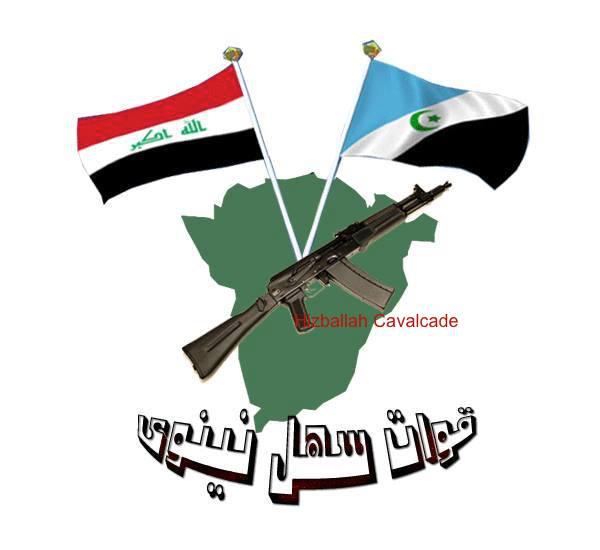
Figure 1: Quwat Sahl Nīnawā’s logo. The Iraqi (left) and Shabak (right) flags emerge out of a map of the Hamdaniya region of the Nineveh Plain. The symbol also features an AK-102 rifle.
Quwat Sahl Nīnawā (A.K.A. Liwa Sahl Nineveh or QSN) purports to be a Shia Shabak militia associated with the Democratic Assembly of Shabaks (Tajema’ al-Shabak al-Dimokrati or DAS).1 QSN announced itself via a November 23, 2014 official statement posted on the website and social media apparatus belonging to the DAS. The group has also already claimed to take casualties in the fight against the Sunni jihadist “Islamic State” (A.K.A. IS, ISIS, or ISIL).2
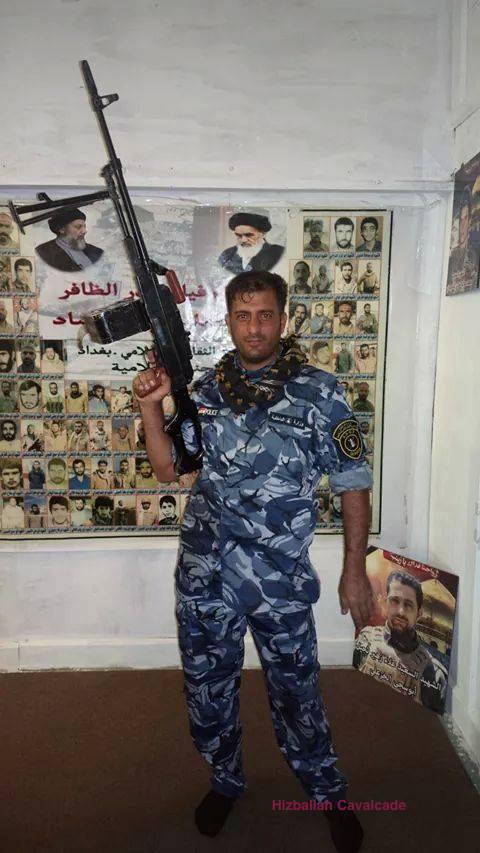
Figure 2: A QSN fighter poses with martyrdom posters (one featuring the dome of Sayyida Zaynab in Syria – bottom right) and other posters featuring Badr Organization founder Ayatollah Muhammad Baqir Sadr and the first Iranian Supreme Leader Ayatollah Khomeini.
Present in the symbols and photos, QSN mixes a limited quantity of Shabak particularism and an added emphasis on Shia identity. On some pages the group has simultaneously promoted links to Iran’s proxy forces. While the group may have relations with Iran’s proxies, its official statements have announced a commitment to “gladly serve the supreme religious authority in Najaf [Grand Ayatollah Sistani].”3 This would likely indicate the group is not an equivalent (in terms of ideology and/or levels of control) to newer Iraqi Shia Iran-proxy militias such as Hizballah al-Abrar.
Photos claiming to show the group training also indicate that they may be assembled along the lines of a “Popular Assembly/Mobilization” or “al-Hashd al-Sha’abi” type group. Photographs of claimed QSN fighters holding flags promoting al-Hashd al-Sha’abi add further credence to this likelihood. Organization along those lines would mean many of the fighters are possibly newer recruits trained and likely led by more experienced personnel and advisors.
In photos of QSN, around 100 fighters were shown posing in ranks. This suggests the numbers for the group are likely in the range of 100-500 combatants.
The creation and promotion of the group may exemplify another method Iran and its proxies are using to place pressure on Kurdish organizations. QSN, as organized along lines of the more dominant Iraqi Arab Shia militias in the south of the country, also demonstrates the direction in which other new militias may be organized. QSN further exemplifies how some of Iraq’s minority groups are mobilizing against ISIS.
The Name & Symbols
QSN’s name directly refers to an area of heavy Shabak habitation, Iraq’s Ninewa (or Nineveh) Plain. Their logo and a post by the Shabak Democratic Assembly describes the group as “Quwat Sahl Nīnawā” or the “Nineveh Plain’s Forces.”4 Albeit, via social media, one page purporting to belong to the group claimed it also went by the name of “Liwa Sahl Nīnawā” or the “Nineveh Plains Brigade”. However, such minor alterations in name are common during the early stages of many new militias.5
The group’s logo also demonstrates a rather rudimentary approach to create symbolism for the new group. Readily available images (including the pictures of an AK-102 rifle, the Shabak and Iraqi flags, and a map of the Hamdaniya area of the Nineveh Plains) were likely pasted together following a simple image search online.6

Figure 3: A QSN fighter poses with a flag associated with the Popular Mobilization type militias.
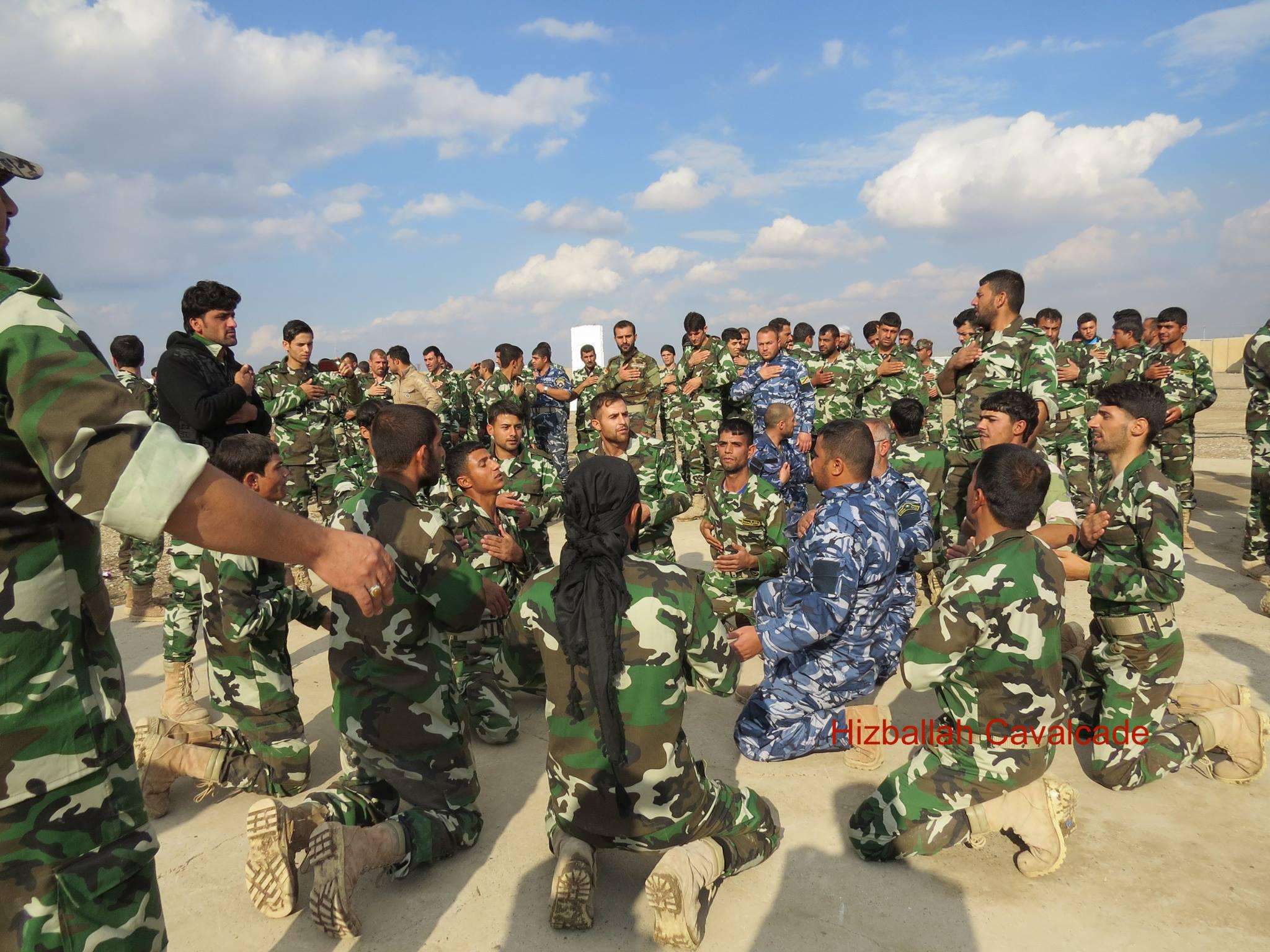
Figure 4: QSN fighters congregate.
Who Are the Shabak & What is the Nineveh Plain?
The Nineveh Plain is a minority rich area; home to the Shabak, numerous Christian sects (including the Assyrians, Chaldeans, and Syriac Orthodox and Syriac Catholics), Turkmen, Yezidis, and Kurds.7 Considered a heartland for Iraq’s Christians, Assyrian Christian and other Syriac (Aramean, Syriac, and Chaldean) Christian nationalist organizations and political parties have pushed for autonomy in the area.8 There has also been a campaign to make the Nineveh Plain its own province (under primarily Christian leadership) within the Iraqi federal framework.9 Nevertheless, the Plain has not been granted a truly autonomous standing.
Many Shabak insist they have a unique ethnic identity, which is neither Arab nor Kurd (albeit, primarily non-Kurdish).10 The group also speaks its own language, Shabaki.11 Most Shabak are also religiously (Twelver) Shia.12
Within the Nineveh Plain, the Shabak primarily live in villages to the east of the city of Mosul, in the Hamdaniya area, and a few thousand also lived in the city of Mosul (before the invasion). Due to ISIS advances, many Shabak hamlets have been overrun.
The Democratic Assembly of Shabak & Issues With the Kurds
While QSN was ostensibly created as a Shabak arm to fight back ISIS threats and offensives targeting the Shabak, there are other underlying trends present with the creation of the militia associated with Shabak-Kurdish relations.
Kurdish groups have shown interest in further incorporating areas of Shabak habitation into Kurdistan.13 As early as 2008, minority groups including the Shabak claimed there was an effort to “Kurdify” areas they inhabited.14
Along with the promotion of a separate non-Kurdish identity, the DAS’s leader and parliamentarian Hanin Qaddo has specifically called out Kurdish parties for claimed abuses against the Shabak. In 2008 Qaddo opposed the incorporation of Shabak inhabited areas into Iraqi Kurdistan.15 Two years later, Qaddo denounced the Kurdish Democratic Party (KDP) for “intimidating” Shabak voters.16 In 2012 the Shabak leader demanded the expulsion of Kurdish and Christian armed forces from the Nineveh Plain.17
With this in mind, QSN’s establishment also recalls the 2012 decision by then Iraqi Prime Minister Nouri al-Maliki to allow for the creation of a 500-man Shabak militia force referred to as, “The Shabak Regiment of Doom.”18
For their part, many Kurdish political leaders have not been supportive of independent Shabak efforts to create their own militias. Nevertheless, some of those Kurdish apprehensions were downgraded following the ISIS advance. Thus, QSN has not been the only Shabak armed group to come into existence. However, its other counterpart is under the control of Kurdish military commanders.19 Whereas QSN is organized along lines set by Baghdad-supported Shia militias and Iran’s proxy groups and does not appear to be taking order from Kurdish commanders.
Tensions between QSN’s DAS parent party and Kurdish parties may explain for QSN’s retention of its independence. The DAS, the largest Shabak Party, is also part of the ruling Iraqi State of Law Coalition. This is the same coalition which included former Iraqi Prime Minister Nouri al-Maliki, the current Iraqi Prime Minister, the Badr Organization and Kata’ib Sayyid al-Shuhada, among other Iranian proxy groups. Nevertheless, Qaddo has “wavered between the Hakim and Maliki factions,” and then ran on the Badr Organization’s electoral list.20
The increase in Iranian proxy cooperation via training, equipping, and other support also speaks to other issues related to Iran’s and their proxies’ policies in Iraq. The policies in question are particularly focused on Kurdistan. From the summer of 2014 until the present, there has been increased tension between Iran’s Iraqi Shia proxies and Kurdish Peshmerga forces.21 Additionally, Iran’s proxies have also threatened Kurdish leaders such as Masoud Barzani.22
A push for support for a group which has already had problems with Kurdish leadership seems to be another avenue for Tehran to exert pressure on the Kurds. Nevertheless, QSN’s main goals and activities have and will likely remain oriented against the existential threat that is ISIS.
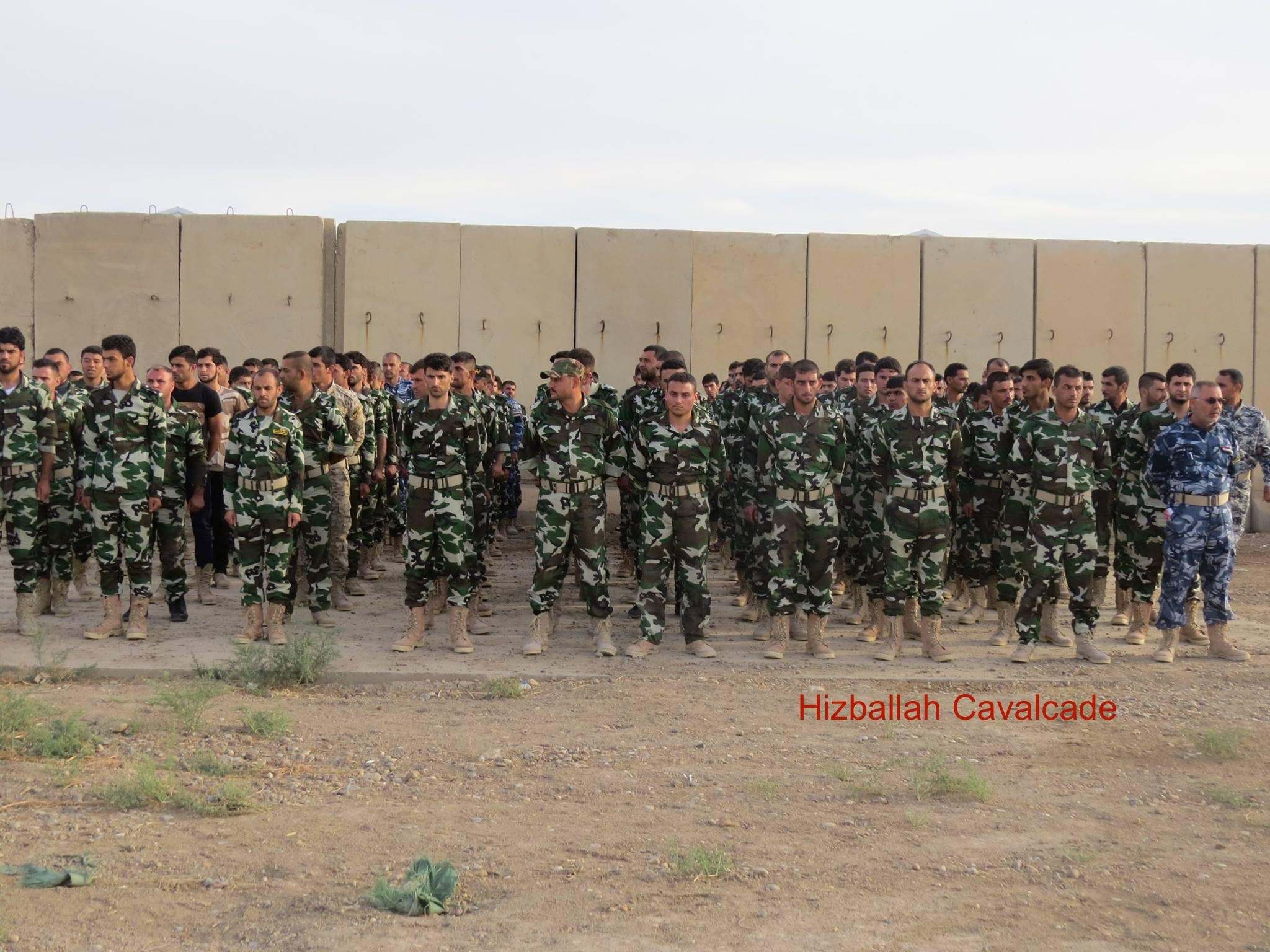
Figure 5: Around 100 QSN are shown in this photo.
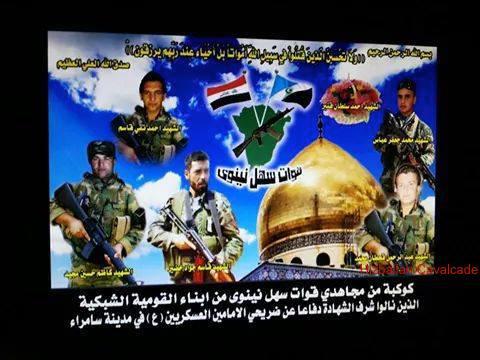
Figure 6: QSN Martyrs are shown on a poster featuring the dome of Syria’s Sayyida Zaynab. It is possible the dome was included by graphics designers to demonstrate that the fight in Syria and Iraq, marketed as “protection for shrines”, are one in the same.
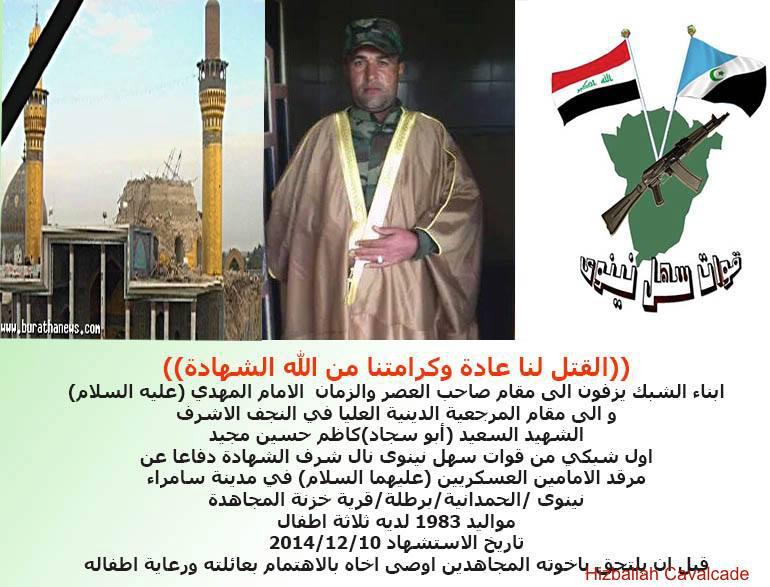
Figure 7: The martyrdom poster for Kazem Husayn al-Asharaf (Abu Sajad).
Videos
Notes:
_____________
Hizballah Cavalcade: Saraya al-Karar: Bahrain’s Sporadic Bombers
NOTE: For prior parts in the Hizballah Cavalcade series you can view an archive of it all here. This piece is part of Hizballah Cavalcade’s “Pearl & The Molotov” sub-series on Bahraini Shia militant groups.
—
Saraya al-Karar: Bahrain’s Sporadic Bombers
By Phillip Smyth

Figure 1: Saraya al-Karar’s newest logo. This symbol was first used in mid-August 2014.
Along with a number of other Bahraini Shia militant organizations, Saraya al-Karar (SaK) came onto the scene in early 2014, announcing itself via the creation of a Facebook page and a Twitter account. At first, SaK mirrored other declared militant groups like Liwa ‘Abis—Smaller than other groups, possibly a front, not as well established, and it appeared likely (as with what happened with the aforementioned organization) that after an initial wave of activity, the group would fade into obscurity. Additionally, the organization initially appeared to be either a front-group for other more established Bahraini militant groups like Saraya al-Ashtar or Saraya al-Mukhtar. While the links to those groups and what appears to be a growing public alliance between them is in the footing, the group has continued its periodic bombing campaign.
Weapons and Operations
The weapons systems SaK prefers to deploy appear to be improvised explosive devises (IEDs). Additionally, their targets have been, almost exclusively, Bahraini police officers. In general, this fits a model witnessed with other Bahraini militant groups, which have primarily targeted internal security forces.
SaK’s first round of bombings began with an announcement on February 13, 2014. The next attack occurred over a month later in March, when the group claimed an attack against a vehicle. The following attack launched by SaK occurred a month after their claimed attack on a vehicle; this time SaK claimed to target Bahraini “troops.” In both attacks, no casualties were claimed. Once again, a month later another attack was announced.
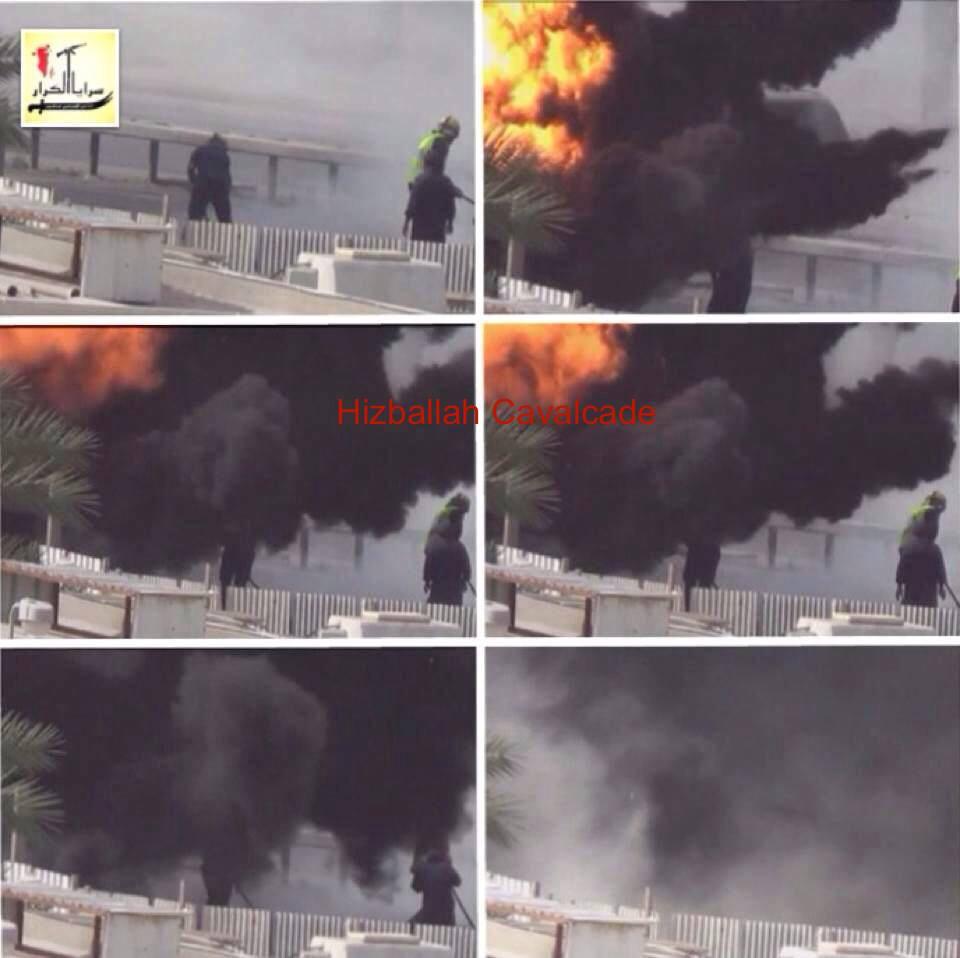
Figure 2: SaK’s July bombing photos (posted on July 8, 2014).
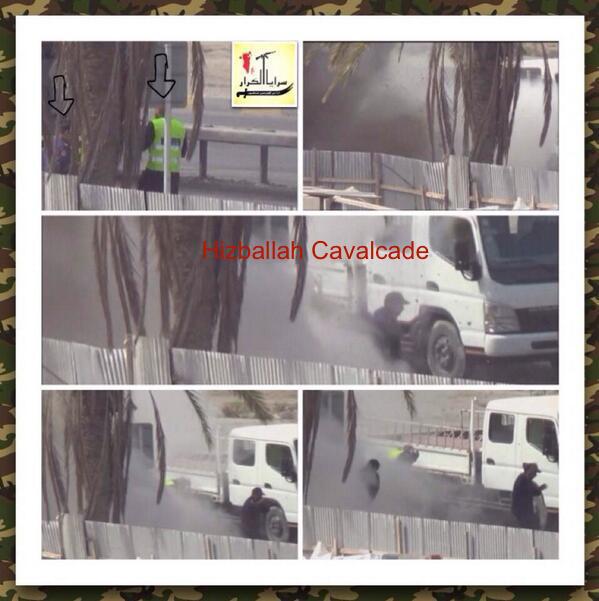
Figure 3: Another July SaK bombing photo series (posted on July 14, 2014).
After SaK claimed attack in late-May, the group appeared to go quiet. However, beginning in July, 2014, the organization began a renewed bombing campaign. As before, the organization targeted Bahraini police. However, unlike previous events, SaK released a series of images throughout their social media apparatus. Throughout July, a number of what appeared to be video captured photos were pieced together and posted by the group. The last of these images was for a bomb targeting a police deployment in Al-Qurayyah. Later in August, a video was posted online showing the Qurayyah attack.
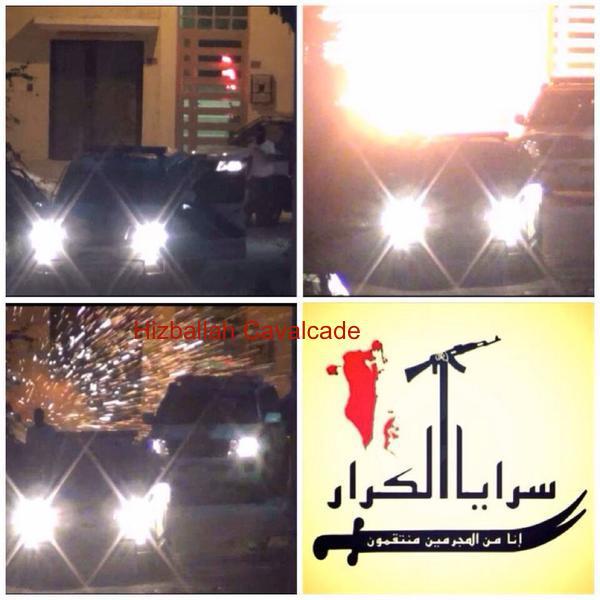
Figure 4: Posted video captures from the SaK August bombing video. This photo set was posted on July 26, 2014.
However, the posting of the video (posted here) did not initially occur on an official account belonging to Saraya al-Karar. In fact, SaK, using other social media platforms, published two video versions of the attack. Neither of these clips featured the group’s logo. However, one of the clips and the main re-edited video both included the instrumental sections from Hizballah singer/songwriter Ali Barakat’s “Nasheed Faylaq Badr al-Iraq” (The song of Iraq’s Badr Corps).1 It is important to note that other Bahraini militant organizations have utilized Iranian proxy produced militant songs for their own productions. What level of connection this shows, if any, between SaK and Iran and/or their proxies are unknown.
At the time of this writing, the most recent SaK attack occurred in November in the Bahraini town of Diraz. The bombing reportedly wounded two Bahraini police officers.2 The operation marked another small public turning point with Saraya al-Mukhtar praising the operation via a communiqué.
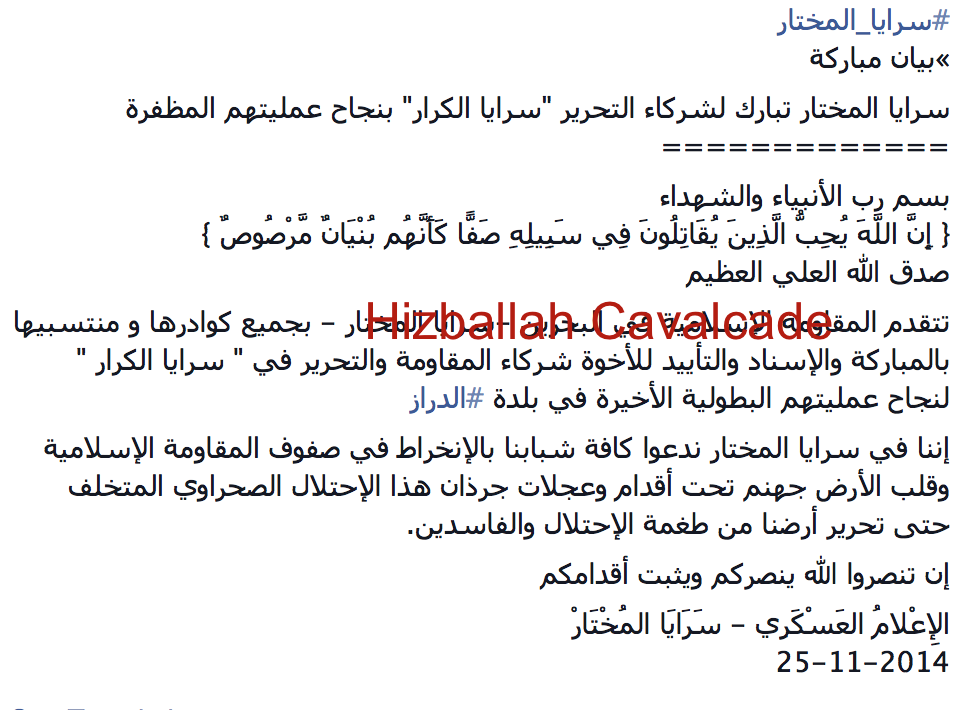
Figure 5: Saraya al-Mukhtar’s praise for SaK’s November operation that wounded 2 Bahraini police officers.
While other Bahraini militant organizations marched in lockstep in regard to their opposition to the Saudi trial and death sentence for radical cleric, Ayatollah Nimr al-Nimr, SaK has made little mention of the religious leader in recent months. However, on August 8, 2014, the group claimed an attack using a firearm in Bani Jamra. The attack was listed as, “Al-Nimr khat al-ahmar” or “the Nimr red line.” The use of the term, “red line” in relation to Ayatollah Nimr’s imprisonment and trial has been a common phrase used by other Bahrani militants.

Figure 6: SaK’s August 8 attack claim.
Symbolism & Saraya al-Karar’s Vocabulary
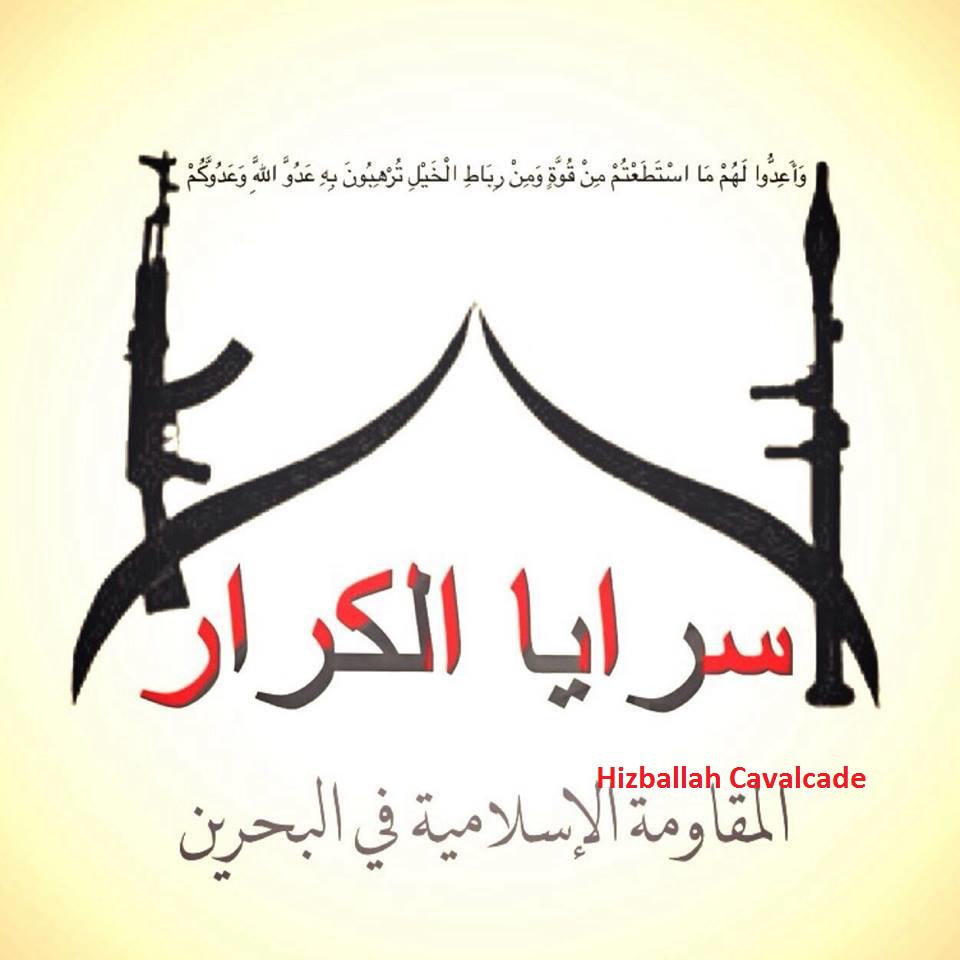
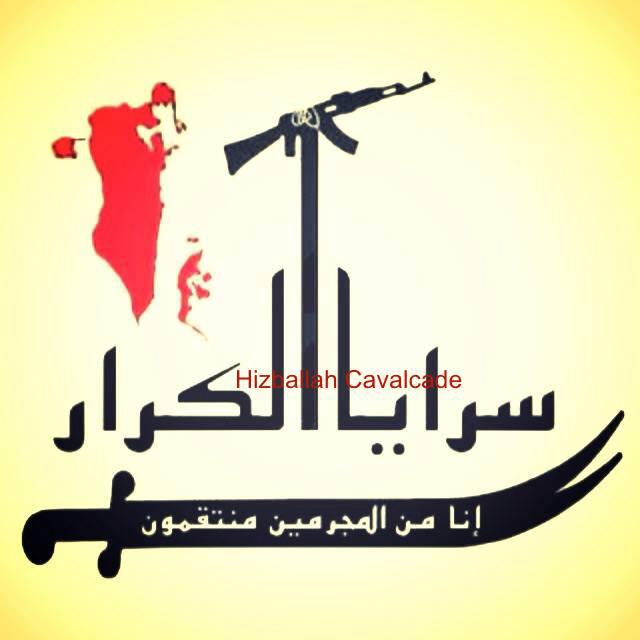
Figure 7 (Left): Saraya al-Karar’s first logo. This symbol was used by SaK from February-July 2014. On the left is a Kalashnikov-style rifle and on the right is what appears to be an RPG-7 type weapons system.
Figure 8 (Right): Saraya al-Karar’s second logo. This symbol, adopted in early July 2014, formed the basis for the current symbol.
SaK’s logo and presentation has seemingly become more professionalized than when the group was first announced. Initially, SaK’s symbol featured an RPG-7 and a Kalashnikov-type rifle flanking a stylized dome over the group’s name. Nevertheless, by the summer of 2014, the group set about changing its imagery into a more Hizballah-style logo with features found on the symbols of other Bahraini militant groups. First, a large red map of Bahrain was added to the logo, along with the fist-clenching-Kalashnikov (emerging from the alif in Al-Karar); a ubiquitous addition to most Iranian proxy group logos. SaK’s logo also received the addition of a Dhualfiqar-style bifurcated sword.
Mirroring other Bahraini militant groups and Iran’s proxies, Saraya al-Karar refers to its fighters as “Rijal Allah” or “Men of God.” Additionally, the SaK has called itself “Al-Muqawama al-Islamiyyah fi Bahrain” (The Islamic Resistance in Bahrain), as have the other Bahraini militant organizations. Like other Bahraini militants, the group calls their foes (Bahrain’s internal security services and police), “mercenaries.” This is a reference to non-native Bahraini individuals (often from the Arab World and the Indian subcontinent) who have joined the state’s security apparatus.
Conclusion
Thus far, SaK has not directly threatened the U.S., other Western, or Saudi interests in Bahrain. However, its public messaging and targets appear to be linked to Bahrain’s other militant groups. It is possible SaK is another Bahraini front group. Nevertheless, its continued operations appear to be establishing an independent identity for the organization. SaK attacks may continue to strike Bahraini security forces. Yet, only time can tell whether SaK will carry out future operations against other targets.
NOTES:
___________
1 See: https://www.youtube.com/watch?v=GYr-kdQeph8.
2 See: https://www.policemc.gov.bh/en/news_details.aspx?type=1&articleId=24462.
Hizballah Cavalcade: The Shia Militant Response to Ayatollah Nimr al-Nimr’s Death Sentence
NOTE: For prior parts in the Hizballah Cavalcade series you can view an archive of it all here.
—
The Shia Militant Response to Ayatollah Nimr al-Nimr’s Death Sentence
By Phillip Smyth
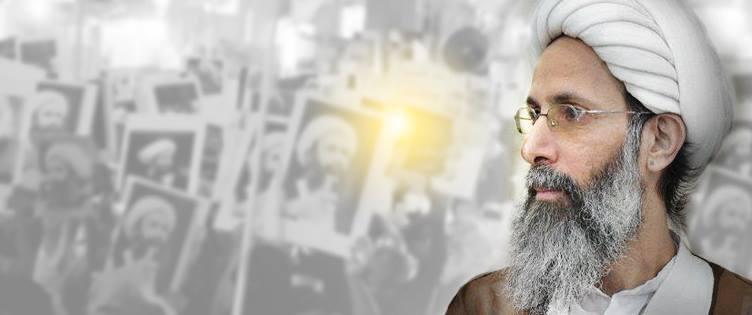
Ayatollah Sheikh Nimr Baqr al-Nimr, an outspoken radical Saudi Arabian Shia cleric, has been the center of controversy and brewing conflict between Shia protesters, militant Shia groups of Saudi Arabia and Bahrain, and their respective Sunni governments. According to a 2012 article by Toby Matthiesen, al-Nimr was, “long a peripheral figure in the local Shia power struggle but now seems to have become the most popular Saudi Shia cleric among local youth.”1 His cause and image is spreading across the Middle East as the latest example of Sunni oppression of Shia in the region and his recent death sentence has become a potent rallying cry for regional Shia militant organizations, particularly those with links to Iran.
Arrested in 2012, Nimr was accused by the Saudi government’s Special Criminal Court of making sectarian statements to cause strife, inviting foreign intervention (shorthand for Iranian influence), and disobeying the king. Following his 2012 arrest, thousands took to the streets and Saudi police shot and killed two protesters.2 In mid-October 2014, Nimr was sentenced to be “crucified”, a process where the sheikh will be beheaded and his body displayed.3
Protests in Saudi began in early 2011 and in part addressed anti-Shia discrimination suffered by the group in the Shia majority area in Saudi Arabia’s oil-rich Eastern Province; primarily zones around the Shia-majority towns and villages near the city of Qatif.4 Following the 2011 Saudi intervention in Bahrain, protests against the Saudi government increased in Bahrain and Saudi Arabia among Shia protesters.5 Following the 2011-2012 protests, links between Bahrain’s and Saudi Arabia’s protest movement spilled over into the more militant circles which actively promoted Nimr’s defiant stance and a hope to combine their fronts against common foes.
Of further interest are Nimr’s own ideological leanings and how they may relate to Shia militant responses. In Frederic Wehrey’s Sectarian Politics in the Gulf, the sheikh is described as a follower of the late Ayatollah Muhammad al-Shirazi.6 Shirazi was one of the founders of a radical Shia political school of thought referred to as the “Shiraziyya.” Shiraziyya clerics have been some of the most influential in the Arab Shia world. Initially al-Shirazi agreed with the Islamic revolutionary ideology of Ayatollah Khomeini, only to split from Khomeini over issues regarding how the new Islamic state (in Iran post 1979 revolution) should be led.7 In one BBC Arabic report, Nimr had been accused by Riyadh of attempting to spread Wilayat al-Faqih.8 Absolute Wilayat al-Faqih is the Khomeinist concept that serves as the basis for the Islamic Republic of Iran. Nevertheless, it was not clarified whether this was the type of Wilayat al-Faqih Nimr was accused of propagating.
Despite the history of strife between Shirazi’s school of thought and that of Ayatollahs Khomeini and Khamenei, al-Nimr appeared to increase public support for Tehran and send other more mixed messages. In 2008, he had also reportedly stated he supported Iran’s nuclear program by saying any attack against it should be met by a response from the Islamic world. That same year, he also said that Saudi Shia may need to call on foreign support (implying Iran) to help press their issues in Saudi Arabia.9 Later in 2009, Nimr reportedly called for secession, stating during a sermon, “Our dignity is more precious than the unity of this land.”10 His statement came as a response to discrimination against Shia in the kingdom and reflected possible repercussions if certain demands made by Shia protesters were not addressed.
Since 2013, in a piecemeal fashion, social media accounts associated with Iranian proxy groups in Iraq have promoted the images and other supportive statements for Ayatollah Nimr al-Nimr.11 While this does not necessitate that Nimr is a true ally or proxy of Tehran, his message and influence is likely seen by Iran as a cause to be promoted in that country’s wider struggle for the leadership of Shia Islam and as a counter to Saudi Arabia.
Nimr’s deep links and strong voice within the Saudi Shia community, particularly among youthful radicals and other more non-violent protestors, has led to Shia militant groups championing his cause from Bahrain and Iraq. Even in Yemen, Shia supporters of Ansar Allah, more commonly known as the Houthis, even launched demonstrations for the jailed cleric.12 Some Bahraini militant groups, which view the struggle of their coreligionists in a geographically close region of Saudi Arabia, as part and parcel to their conflict with the Khalifa monarchy and their Saudi government supporters. Additionally, powerful Iranian proxy groups based in Iraq—which have also maintained anti-Saudi and anti-Bahraini government narratives—have taken to issuing stern threats against Riyadh for his sentence.
The Violent Replies From Saudi Arabia’s and Bahrain’s Militants
Bahraini militant groups demonstrated the most concerted effort in terms of orchestrating violent retorts to Nimr’s jailing and sentence. While other threats and attacks were conducted since the start of 2014, this piece will focus on more recent threats and attacks beginning in the summer of 2014.
Bahrain’s Saraya al-Mukhtar (SaM), a group which once said the Saudi Shia of the Qatif and the Shia of Bahrain constituted one people with common foes, launched the most attacks over the longest period specifically addressing Ayatollah Nimr al-Nimr’s arrest, trial, and death sentence.
Starting in August, SaM attacked an electricity tower in Ar-Rifā near a Bahraini military base. The group filmed the attack and stated it had been a warning related to the imprisonment and trial of Ayatollah Nimr al-Nimr. Around the same time, SaM also began an online countdown for the Nimr verdict and increased their threats against Saudi Arabia. The group also ratcheted up it’s pro-Nimr messaging with the release of numerous images.
This messaging coincided with Saraya al-Mukhtar making its first direct threat against U.S. military personnel in Bahrain on August 11. Through an image posted to Facebook, SaM stated that, “The American cover on al-Saud and Al_Khalifa crimes,,Marines in bahrain will pay the price. [sic]” The message essentially claimed that the U.S. was the real backer for the Khalifa and Saud monarchies. As a result, they bore equal responsibility and could be targeted.

Figure 1: Saraya al-Mukhtar’s anti-American message posted on August 11, 2014.
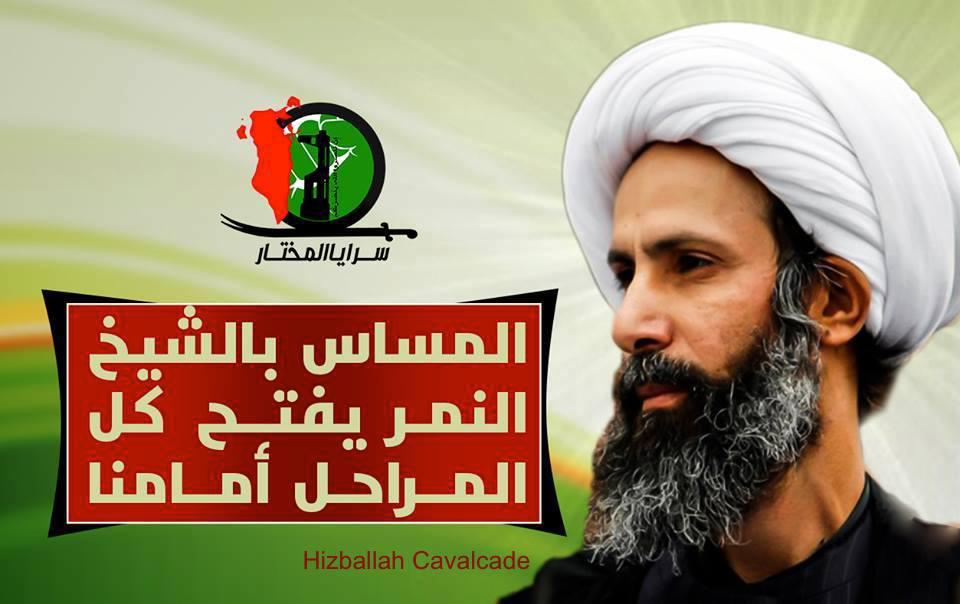
Figure 2: A Saraya al-Mukhtar photo for Ayatollah Nimr al-Nimr posted on August 8, 2014. The poster reads: “Sheikh Nimr[‘s trial and poor treatment] will make us put all options on the table.”

Figure 3: A Saraya al-Mukhtar photo posted on August 10, 2014. This poster reads: [in the red box] “A warning from Saraya al-Mukhtar to the mafia of the Sauds [in white text] Harming Sheikh Nimr will make us put all options [on the table]. Harming the Faqih Nimr means every single Saudi national will enter our country in a coffin.”
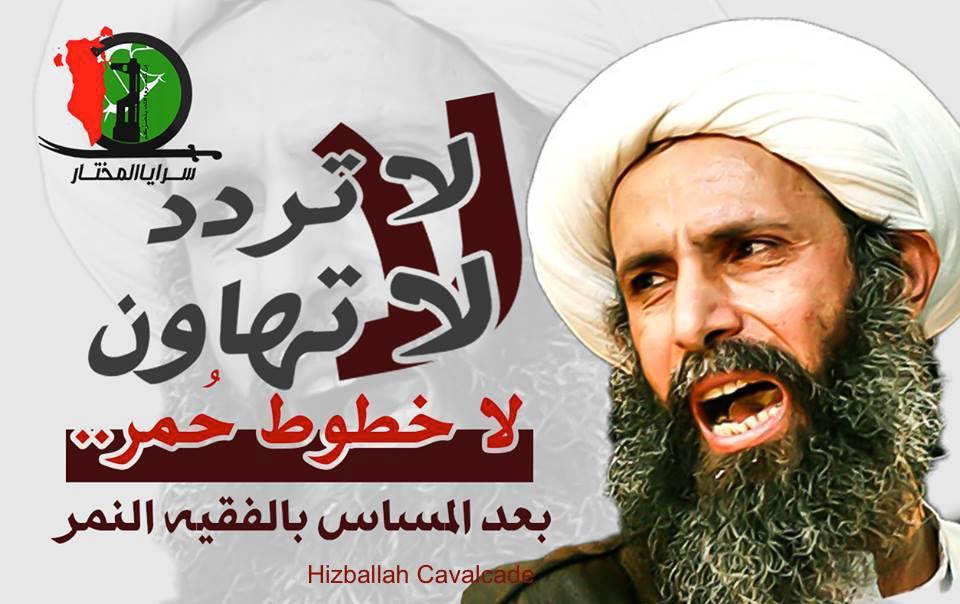
Figure 4: A Saraya al-Mukhtar photo for Ayatollah Nimr al-Nimr posted on August 11, 2014. The poster reads: “Do not hesitate, Do not underestimate, No red lines.. after [the] discrimination [against] the Faqih al-Nimr.”
On September 16, SaM announced it had planted 6 explosive devices in retaliation for al-Nimr’s incarceration. Albeit, these bombs did not target U.S. interests and there was little confirmation as to whether any devices were actually planted.
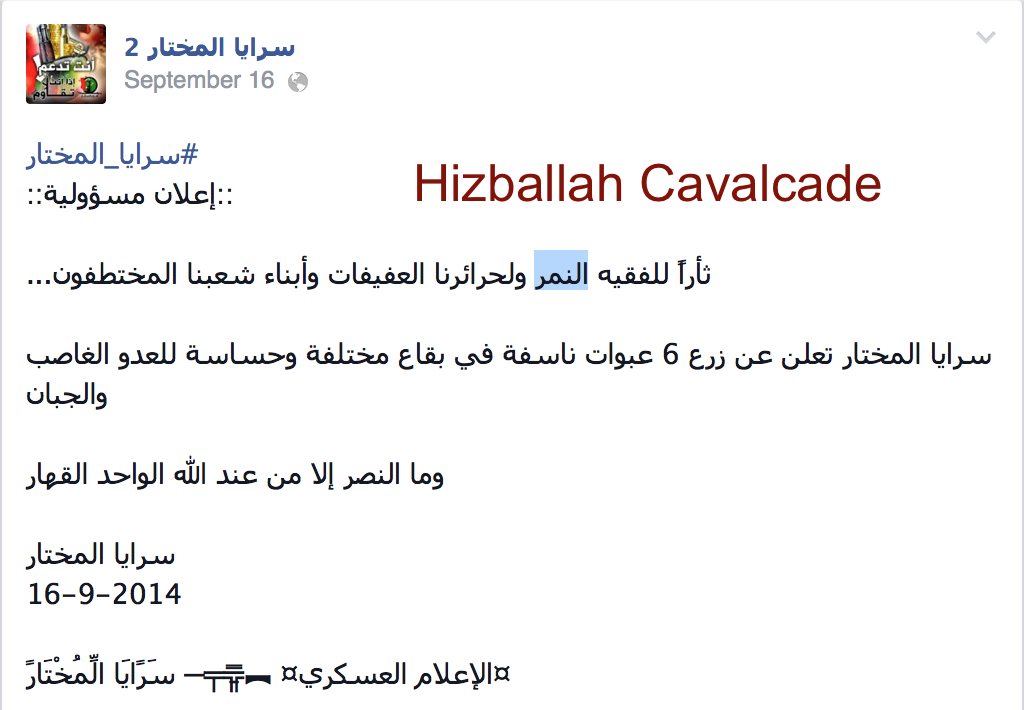
Figure 5: Saraya al-Mukhtar’s September 16 claim to have planted 6 bombs.
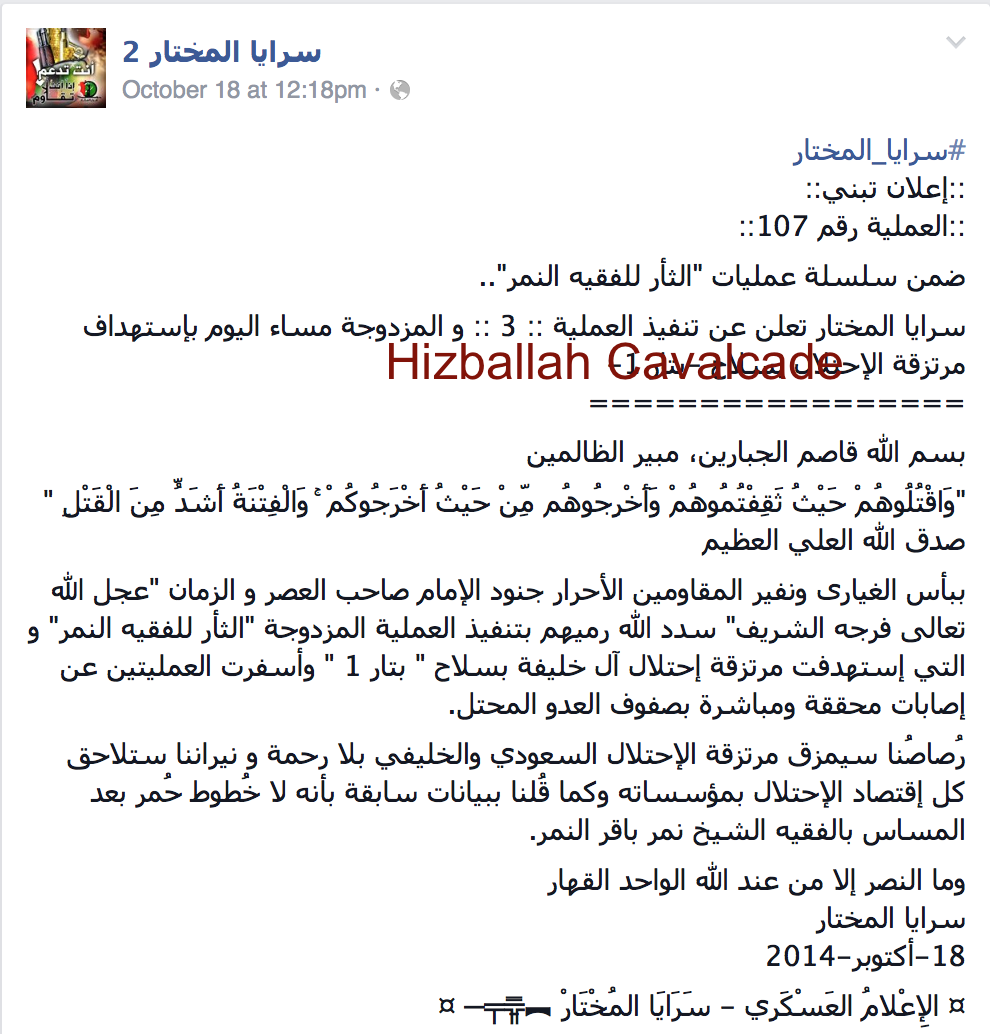
Figure 6: Saraya al-Mukhtar’s claim of 2 attacks on October 18, 2014.
Then on October 9, SaM claimed to conduct an attack in the town of Karana, Bahrain utilizing an improvised firearm. SaM’s claim of responsibility stated they attacked, “herds of mercenaries” (shorthand for Bahraini police and other security entities). On October 15, SaM claimed to have launched attacks in Sanabis and Aker, Bahrain targeting “mercenaries”. In another statement from that day, the group threatened, “The occupying mafia of al-Saud and al-Khalifa [would face]…consequences for the death sentence.” Later, on October 18, SaM claimed two attacks, referring to them as “Revenge of the Faqih [an expert in Islamic jurisprudence] Nimr.” SaM’s statement declared that it had injured “ranks of the enemy occupier.”
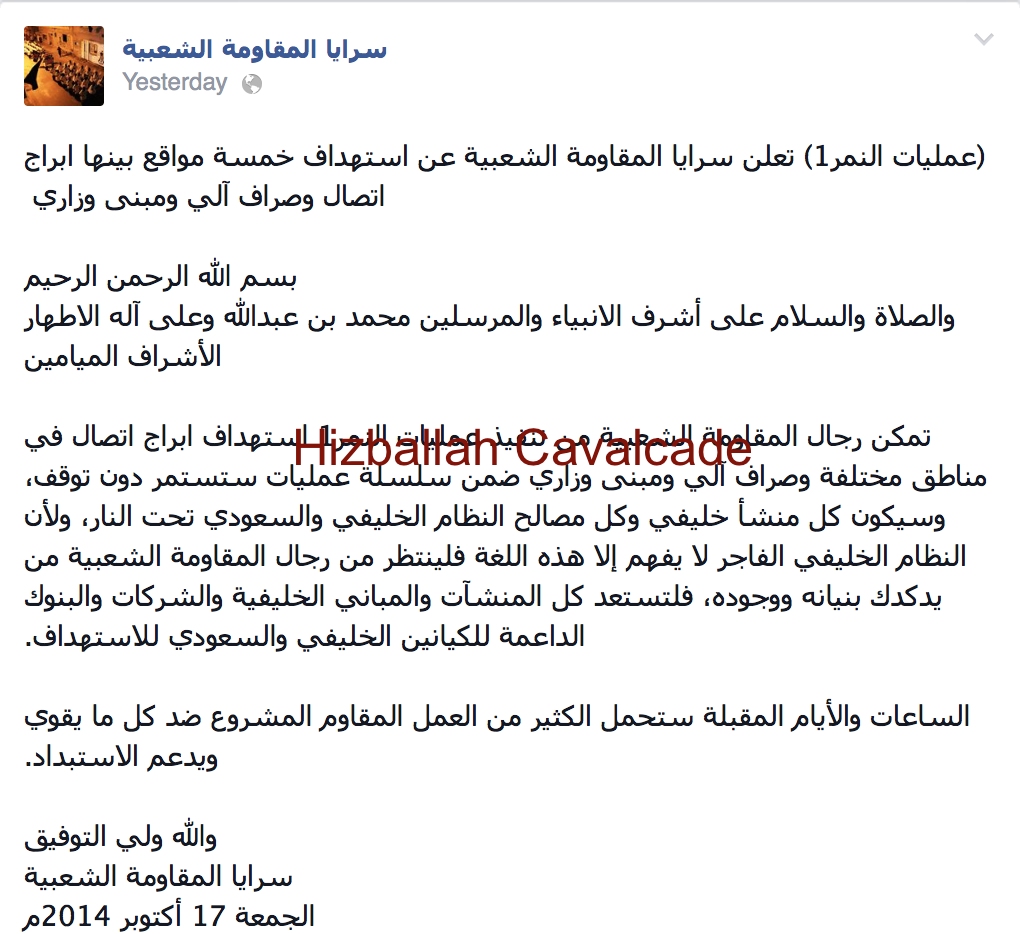
Figure 7: SMS’s claim of attack in honor of Sheikh Nimr.
Bahraini militant group, Saraya
Hizballah Cavalcade: Ansar Allah al-Awfiyya: One of Many New Khomeinist Militias in Iraq
NOTE: For prior parts in the Hizballah Cavalcade series you can view an archive of it all here.
–
Ansar Allah al-Awfiyya: One of Many New Khomeinist Militias in Iraq
By Phillip Smyth

Figure 1: AAA’s logo. The symbol features the fist-gripping-a-Kalashnikov symbol, which is nearly ubiquitous among Iranian proxy groups.
On August 10, 2014, Ansar Allah al-Awfiyya (The Loyal Partisans of God or AAA), a Shia jihadi militia, announced its existence via Facebook and cast itself as a militia whose purpose is to assist in fighting Sunni Jihadi groups such as the Islamic State (IS, also known as ISIS or the Islamic State of Iraq and al-Sham) and the “Ba’athists” (likely a reference to the Naqshbandi Army or JRTN). Two weeks following its declarations of existence, the group had already reported its first losses.
The group has cast itself as supportive of the Iranian Supreme Leader and attempts to appeal to Iraq’s large Sadrist Movement (Al-Tayyar al-Sadri) by incorporating images of the late Ayatollah Muhammad Muhammad Sadiq Sadr.
Proxy Overlap

Figure 2: A “martyrdom” poster released for a Liwa al-Hamad militant killed in Syria. The poster was circulated by and featured the logo of KSAI’s media wing.
While new and relatively unheard of, AAA did not emerge from a void. As with other Iranian proxies, the group has listed itself as one of the many groups belonging to “al-Muqawama al-Islamiyyah fi al-Iraq” (“The Islamic Resistance in Iraq”). Yet, its “Muqawama” credentials are simply one piece to a larger interconnected Iranian proxy network.
Shaykh Haydar al-Gharawi, Secretary General of Kayan al-Sadiq w al-‘Atta fi al-Iraq (KSAI or The Group of Honesty and Caring in Iraq) announced AAA as a militia associated with his small Maysan Province based party. LSAI has been politically active since 2012 and has had members serve on Maysan’s provincial council. In June, one LSAI leader on Maysan’s provincial council declared the province would allocate billions of Iraqi dinars to assist with training for volunteer fighters.1
KSAI has also promoted its association with Akram Kaabi, the Secretary General of Liwa al-Hamad’s parent group, Harakat Hizballah al-Nujaba. Since HHN has sub-militia groups, such as Liwa Ammar Ibn Yasir and Liwa al-Imam al-Hasan al-Mujtaba, it appears that KSAI has the most extensive links with HHN’s Liwa al-Hamad. These associations were exposed via Facebook posts earlier in 2014 via the posting of “martyrdom” notices from the group about a member killed fighting as part of Liwa al-Hamad. Additionally, the same style of graphics used for Liwa al-Hamad’s online posts are replicated. Further demonstrating the deep links between Liwa al-Hamad and AAA, Liwa al-Hamad’s official Facebook pages have even adopted the logo of AAA.
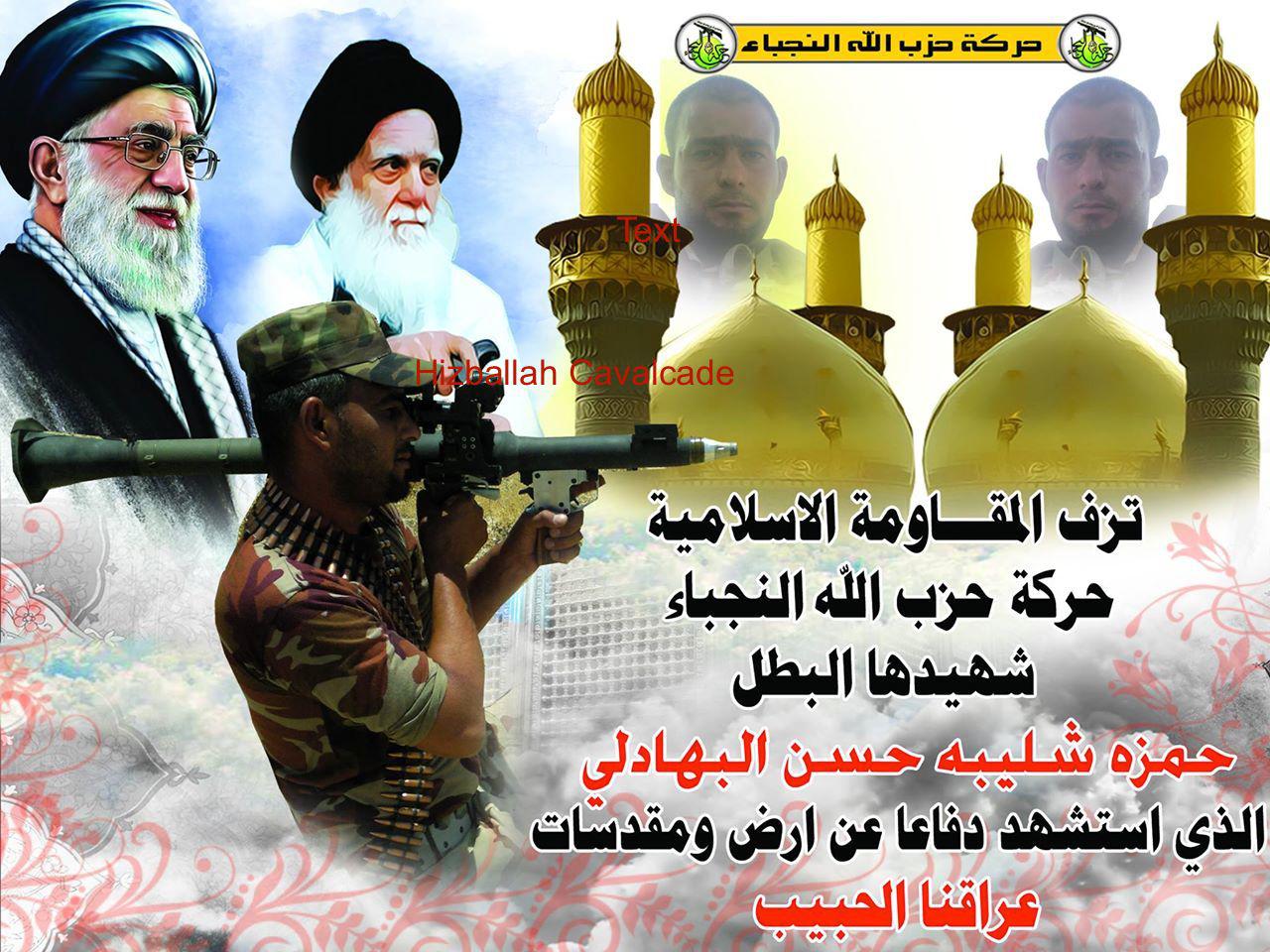
Figure 3: A “martyrdom” poster for a HHN member. The image is the same model used by AAA.
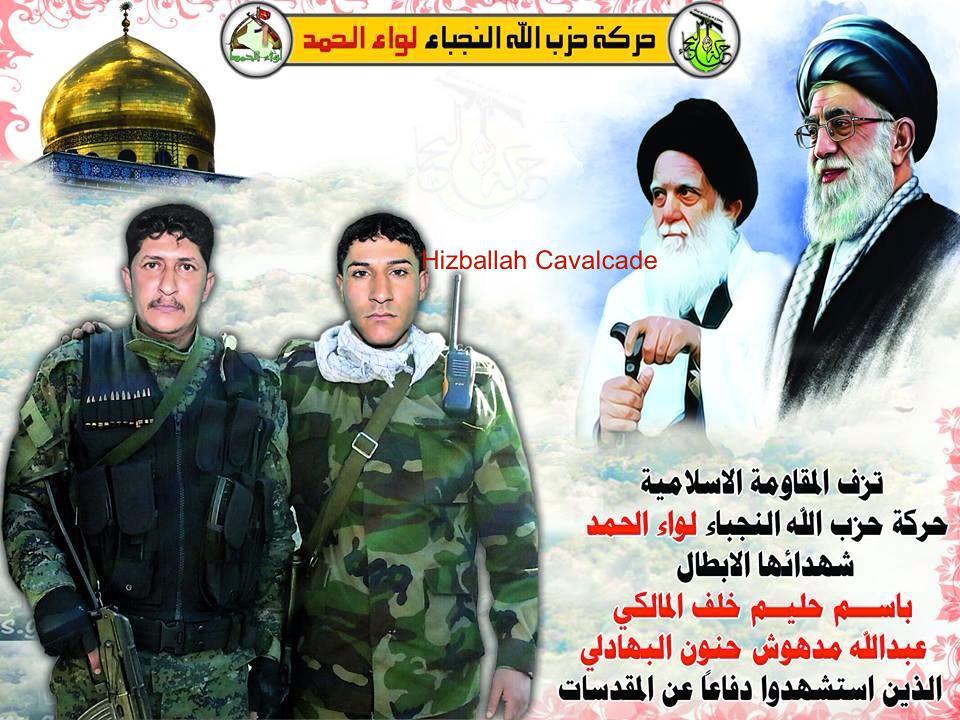
Figure 4: A “martyrdom” poster for Liwa al-Hamad. This model is the same as AAA’s “martyrdom” imagery.
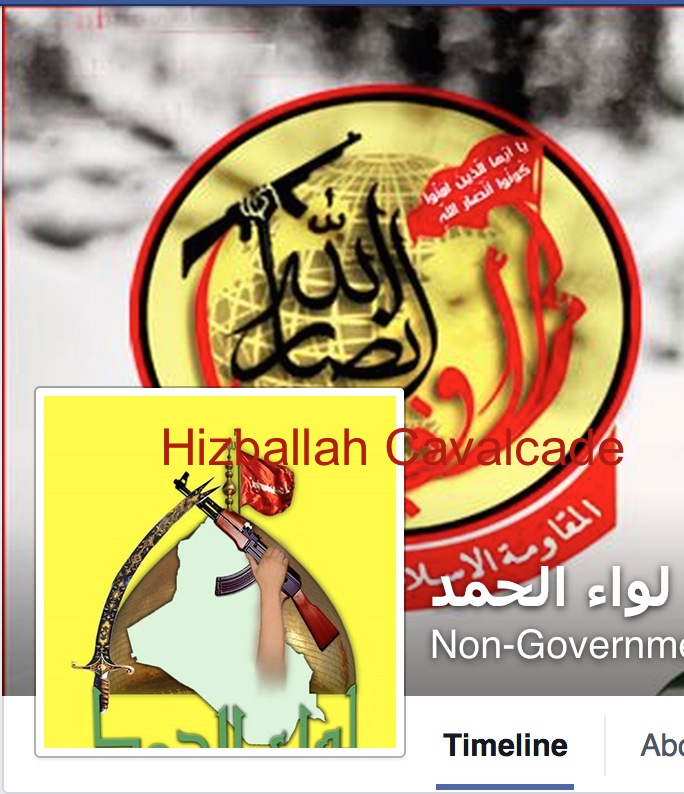
Figure 5: Liwa al-Hamad’s official Facebook page has also adopted the AAA logo.
Ansar Allah al-Awfiyya has also claimed it is affiliated with Harakat Ansar Allah al-Awfiyya, (The Movement for the Loyal Partisans of God). It is unknown whether the group is attempting to market itself as a separate or unified movement with LSAI, or simply using the term “Harakat” (“Movement”) to appear larger and/or more developed. Nevertheless, the creation of multiple interlinked groups utilizing commanders who were members of other established organizations is a common strategy within the realm of Iran proxy militias.2
Ansar Allah al-Awfiyya Joins the Battle
AAA has not yet announced the areas of Iraq in which their armed forces are operating. However, other details have emerged. Shaykh Haydar al-Gharawi, the Secretary General of KSAI has now been simultaneously described as AAA’s Secretary General. From released images, the group appears to follow the same types of tactics utilized by other groups when they have gone about asserting their presence in the arena of Iraqi Shia militias. The group has pressed civilian vehicles into service and declared the deaths of two members, including a commander, Muhammad Abdul Amir Ibrahim al-Assadi.
It is likely AAA is organized along the lines of other Iranian proxies, with the militia borrowing fighters from other established organizations in order to appear more powerful and established. Nevertheless, since the group already has a strong regional influence, it is possible it can count on the regional populace it represents to assist with the recruitment of new fighters.
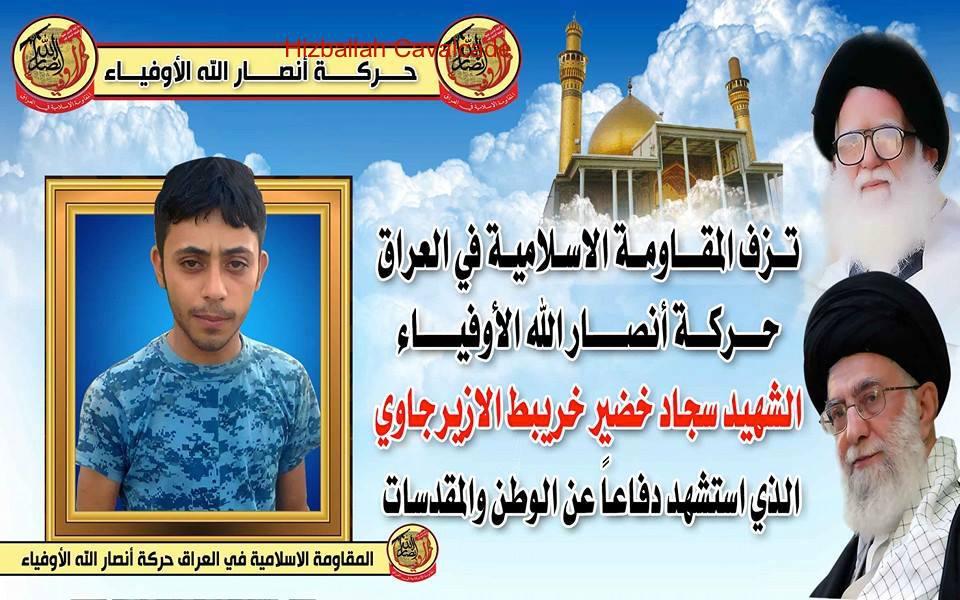
Figure 6: “Martyrdom” poster for an AAA member announced killed on August 31, 2014.
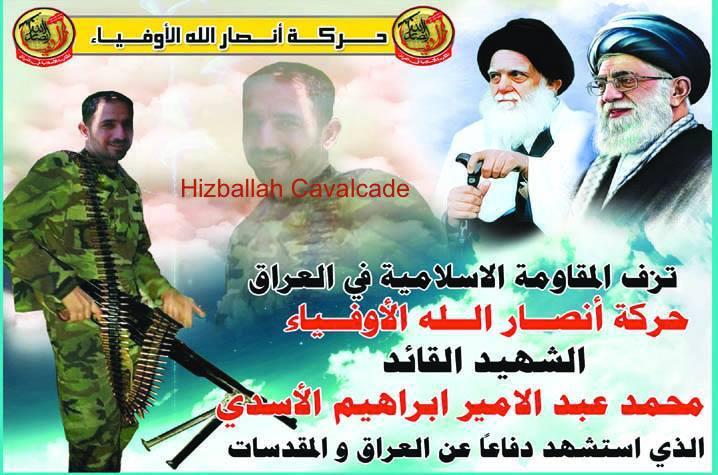
Figure 7: AAA commander Muhammad al-Assadi was declared killed while fighting in Iraq in a number of posts on August 24, 2014.
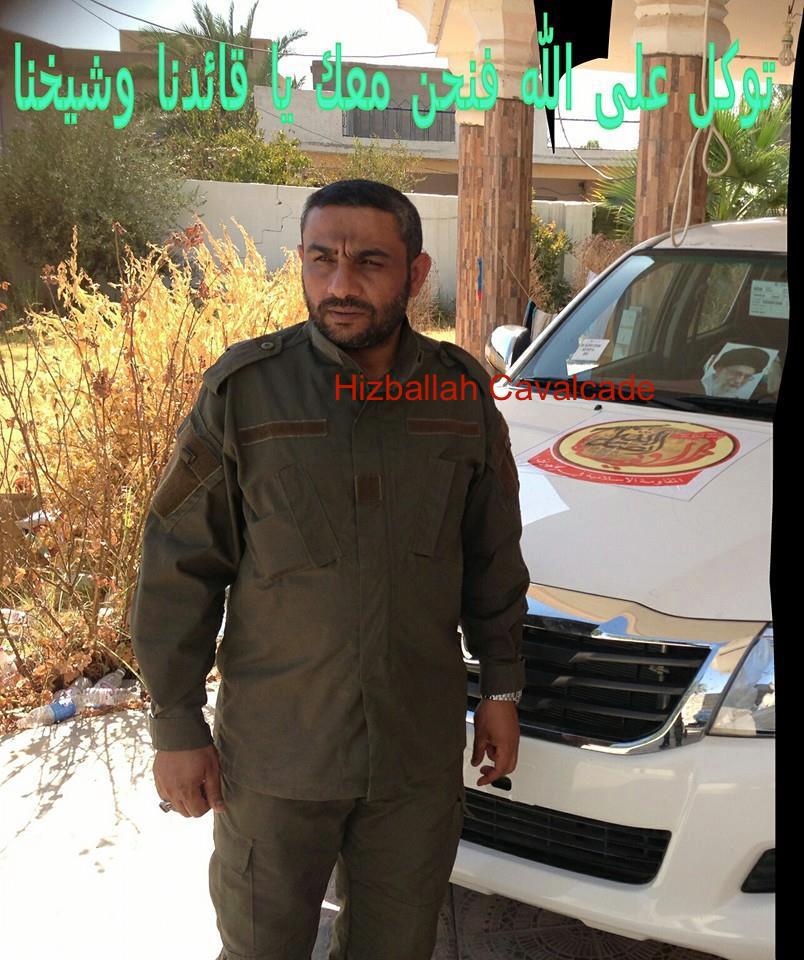
Figure 8: AAA’s secretary general, is shown in uniform posing in front of a car featuring the group’s logo and a poster of Iranian Supreme Leader Ayatollah Khamenei.
_____________
NOTES:
Hizballah Cavalcade: From Najaf to Damascus and Onto Baghdad: Iraq’s Liwa Abu Fadl al-Abbas
NOTE: For prior parts in the Hizballah Cavalcade series you can view an archive of it all here.
—
From Najaf to Damascus and Onto Baghdad: Iraq’s Liwa Abu Fadl al-Abbas
By Phillip Smyth

Figure 1: Liwa Abu Fadl al-Abbas Tashkil al-Iraq’s logo.
Liwa Abu Fadl al-Abbas (LAFA) is still the best known of the Iraqi Shia staffed militias operating within Syria. The creation of the organization and successful marketing of its narrative; which cast the group as the “defenders of the Sayyida Zaynab Shrine” south of Damascus, set the stage for Shia Islamist foreign fighters to join the battle in Syria against rebel forces. Under the leadership of the Syrian Shia “Abu Ajeeb” in Damascus, the group has been deployed to numerous combat zones throughout Syria. While other foreign Shia fighters have been attached to the group, the primary nationality making up the ranks of LAFA has been Iraqi.
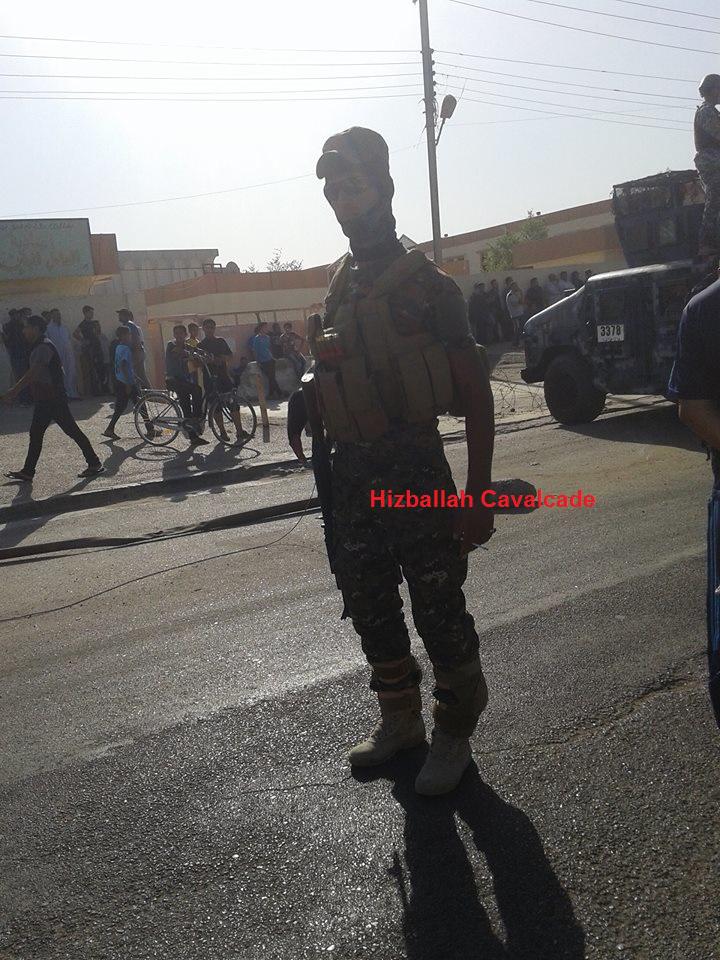
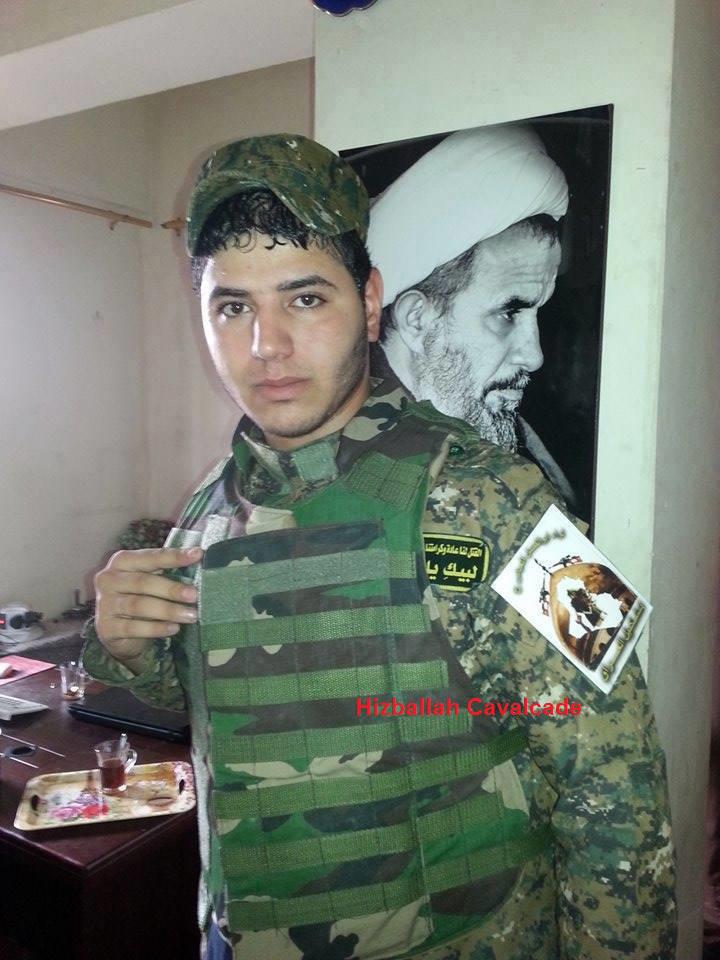
Figure 2: (left) A LAFA-Iraq fighter stands guard near Iraqi government forces. (Right) Another LAFA-Iraq member stands in an office.
Yet, LAFA’s name and possibly their geographic reach changed in 2014. Instead of using Iraq as a place simply to recruit more members for activities in Syria, LAFA adopted a new role as a Shia militia within Iraq. In fact, the new Iraq-focused LAFA may have more limited connections to the LAFA in Damascus, yet this does not mean that Iraqi Shia fighters affiliated with the Syrian-based LAFA are not active within the newer group’s ranks or have a longstanding affiliation with the new Iraq-based group.
The Iraq-focused section of LAFA, known as Liwa Abu Fadl al-Abbas Tashkil al-Iraq, (The Abu Fadl Abbas Brigade Iraq Formation or LAFA-Iraq), is led by Sheikh Qasim al-Ta’i. It also appears that LAFA-Iraq’s links are more directly associated with units of the so-called Rapid Reaction Force which was deployed to Damascus in early 2013. The force claims to have affiliations with the Iraq’s Internal Security Forces and Special Operations/SWAT teams.
LAFA-Iraq’s more structured Iraq-focused image first emerged on a number of Facebook pages in March 2014. This coincided with announcements by Iranian Shia Islamist proxy groups that they were actively involved in fighting within Iraq’s Anbar Province against rebel forces, included the Islamic State of Iraq and al-Sham. Often, photos of parading members wearing new Velcro patches featuring the group’s logo were uploaded. It is currently unknown how large LAFA-Iraq’s forces are or if their deployment within Iraq is limited to certain areas. In mid-June a video surfaced claiming the group was patrolling the Mansour section of Baghdad. Another report claimed that LAFA’s fighters in Syria had returned to Iraq in the wake of ISIS advances in the country. Their absence in Syria was reportedly filled by units belonging to Lebanese Hizballah.1 On June 16, 2014 post, it was also claimed that 1500 LAFA-Iraq fighters had been deployed to the holy city of Samarra, home of the Askari Shrine.

Figure 3: A LAFA-Iraq fighter stands in the bed of a pickup truck. His camouflage gear appears similar if not the same as the variety used by Lebanese Hizballah and LAFA forces operating in Syria.
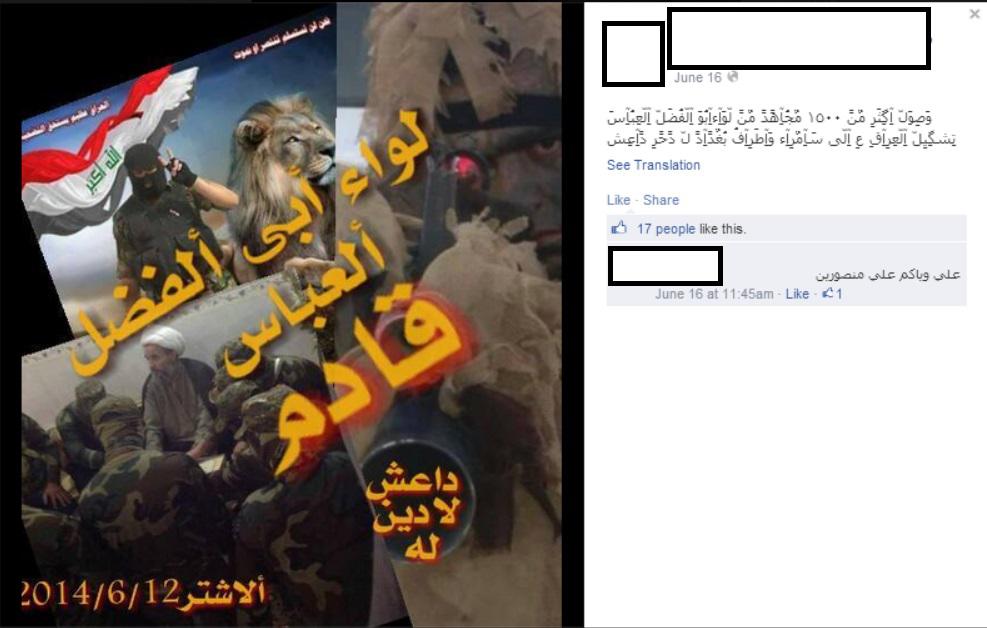
Figure 4: A screenshot of a LAFA-Iraq claim to have sent 1500 of their forces to Samarra.
As Iraq undergoes massive recruitment efforts for Shia fighters, it is likely that LAFA-Iraq has, along with other Iranian-proxy organizations, recruited new members and deployed fighters to key hotspots. Since a main narrative for the group has been their “defense of shrines,” it is possible the group has some contingent stationed in or around Iraq’s many holy Shia mosques/shrines. Additionally, with reports that fighters who gained experience on the battlefields in Syria have come back to Iraq, the group has an added punch.
While the group’s logo is a departure from LAFA-Syria’s more Hizballah themed symbols, it still uses imagery specific to the concepts first honed in Syria. The main theme is the notion of shrine defense, namely the golden dome found on the Sayyida Zaynab mosque/shrine and Shia religious themes present with the image of the historically important Abu Fadl al-Abbas. Abbas stands in the middle of a map of Iraq. Secondly, the more militaristic theme is furthered by the inclusion of two SVD-type sniper rifles. Thus, LAFA-Iraq’s symbolism plays on the fact that its recruits are Iraqi (with the map), but heavily includes transnational religious imagery to build the theme of Shia power and shrine defense.

Figure 5: A group of LAFA-Iraq fighters stand equipped in a 2014 photograph.
Some Distinct Changes in LAFA-Iraq’s Messaging Compared to LAFA in Syria:
- Abu Ajeeb, LAFA’s Syria commander, has not been mentioned by pages associated with LAFA-Iraq. Instead, Iraqi cleric Sheikh Qasim al-Ta’i is listed at the group’s “qa’id” or leader.
- New symbolism linking themes related to Iraq and Syria.
- Sayyida Zaynab’s dome is combined with a map of Iraq.
The Qasim al-Ta’i Connection
1 See: https://now.mmedia.me/lb/en/lebanonnews/551145-hezbollah-announces-general-mobilization-in-syria?. 2 See: https://www.aawsat.net/2009/08/article55253964. 3 https://kassimaltaai.org/PageViewer.aspx?id=126. 4 See: https://www.sotaliraq.com/mobile-news.php?id=95733#axzz34mEL3nh4 5 See: https://mlm.jamestown.org/single/?tx_ttnews%5Btt_news%5D=41080&tx_ttnews%5BbackPid%5D=686&no_cache=1#.U6HdOvldWQ4.
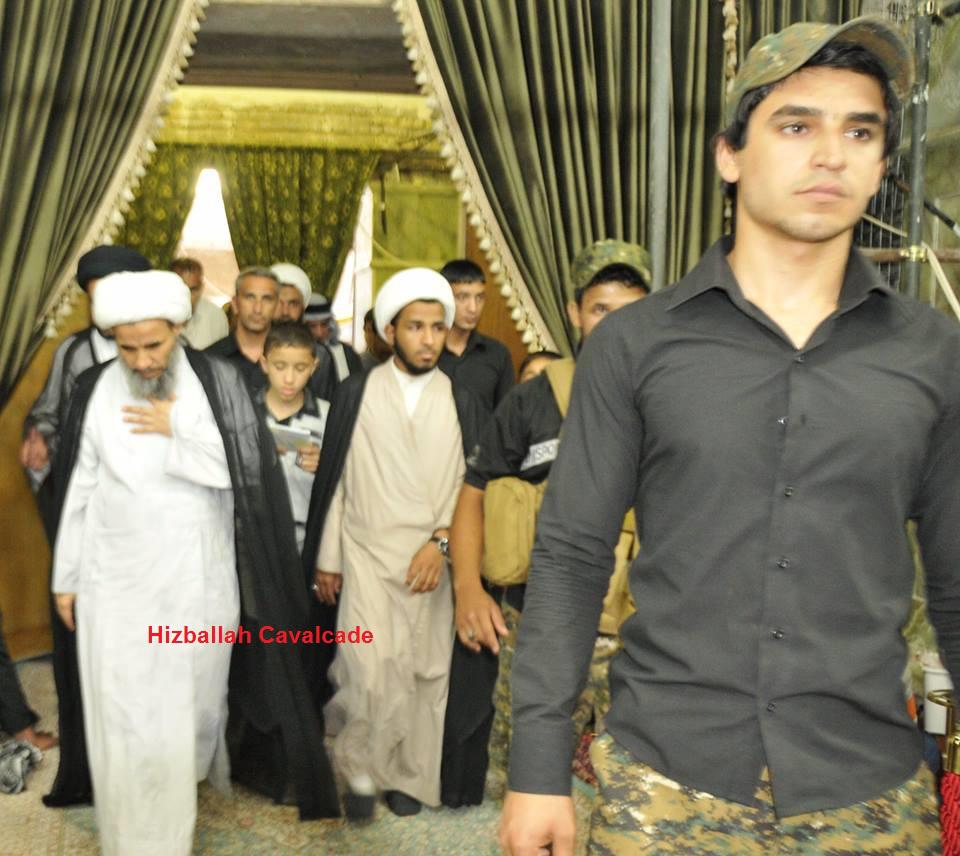
Figure 6: Al-Ta’i (far left in the white turban) with LAFA-Iraq escorts.
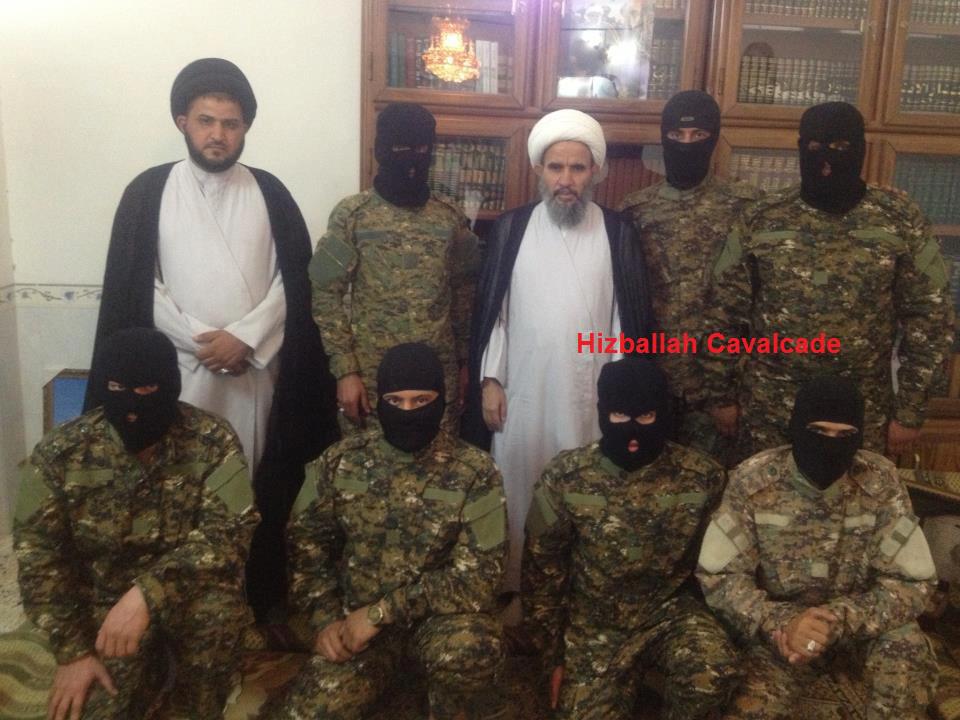
Figure 7: Al-Ta’i poses with Iraqi Shia Islamist militants headed to Syria. The photograph dates from 2013.
Iraqi Shiekh Qasim al-Ta’i, a cleric once supported by Muqtada al-Sadr and had been involved in the movement established by Muqtada al-Sadr’s father, Grand Ayatollah Muhammad Muhammad Sadiq Sadr. After the 1999 assassination of Grand Ayatollah Sadr, Ta’i branded himself as a main leader of the broadly defined “Sadrist movement.”2 Ta’i has also stated he is a supporter of Wilayat al-Faqih, the ideology of Iran’s Islamic Revolution established by Grand Ayatollah Khomeini.3
In April 2013, Ta’i claimed that the initial idea for the creation of LAFA in Damascus, “began in Najaf by a group of youth.” Interestingly, at the time Ta’i evoked memories of the bombing of Samarra’s Askari Shrine in 2006 to explain why LAFA needed to deploy to Syria.4 Today, LAFA-Iraq uses the defense of the Askari Shrine in Samarra as another way to explain why the group needs to be present in Iraq.
Despite Tai’s claims that the group was conceived of in Najaf in 2013, there is ample evidence that LAFA was already well-established in Damascus by the fall of 2012. It is also likely that other Iraqi Shia—splinters from Muqtada al-Sadr’s movement—refugees living in Syria formed the initial group and it was then reorganized and equipped with assistance given by Iranian Shia Islamist proxy groups.
However, al-Ta’i’s relationship with elements of LAFA in Damascus cannot be understated. Ta’i has a number of offices open around the area near Sayyida Zaynab and throughout 2013, he repeated calls for support for the Iraqi Shia-populated sections of LAFA. In some respects, the Iraqi Shia foreign fighter influence on LAFA in Damascus did lead to tensions. In the summer of 2013 there was discord over Abu Ajeeb’s leadership, leading to a firefight.5 Nevertheless, by fall 2013, some well-known fighters associated with LAFA in Syria and al-Ta’i were taped operating together in Damascus (see video: “The Original LAFA Operating in Damascus – Fall 2013”). The creation of LAFA-Iraq under a firmer leadership by al-Ta’i, erasure of other Syrian-based leadership, and utilization of the established group name and faces likely represents the latest evolution for a group which has undergone many transformations since its creation as a Shia-focused popular committee in 2012.
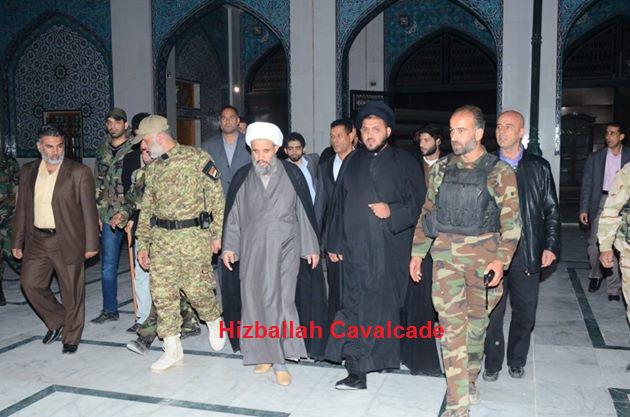
Figure 8: Leaders of the Damascus-based LAFA walk with al-Ta’i.
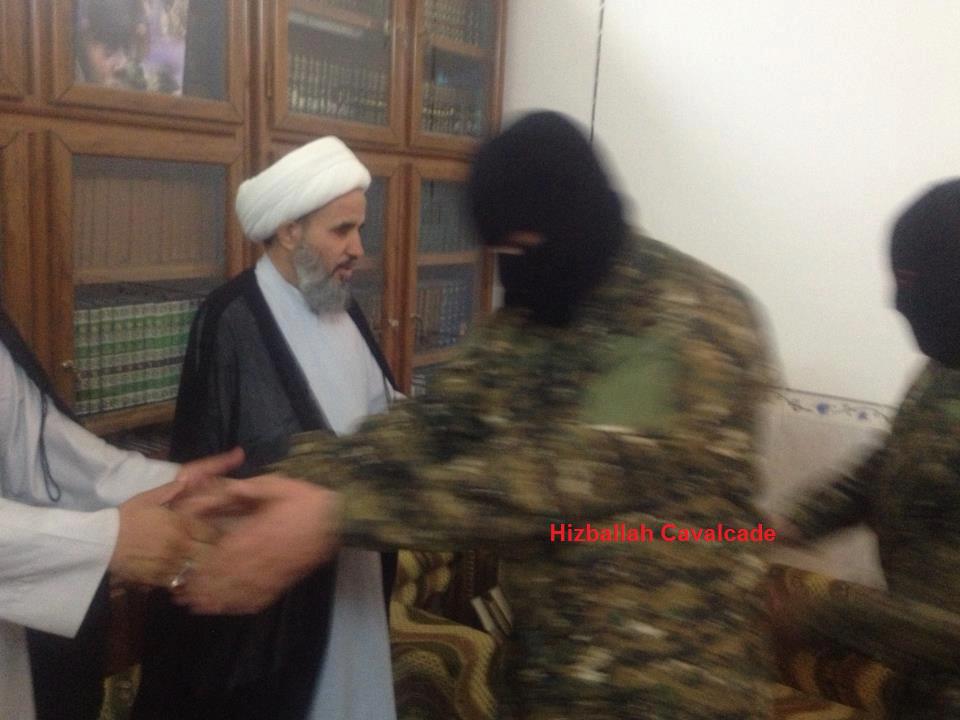
Figure 9: Al-Ta’i blesses Iraqi Shia jihadists planning on fighting in Syria.
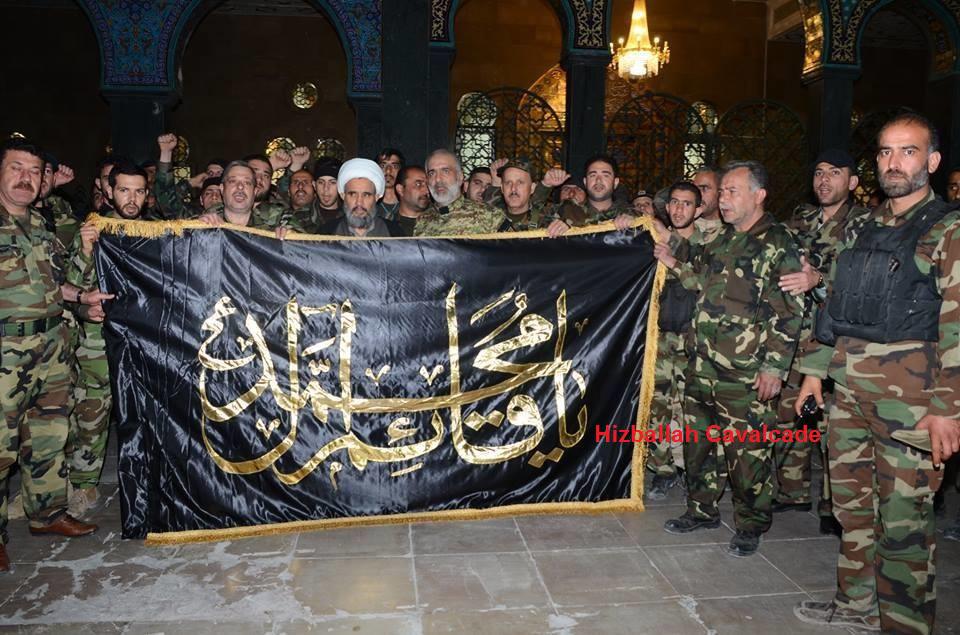
Figure 10: Iraqi Shia members of LAFA. Originally the photograph was distributed by LAFA social media sites. It has now been reprocessed by LAFA-Iraq.
___________
NOTES:
Hizballah Cavalcade: IRGC's First Martyr vs. ISIS in Iraq?
NOTE: For prior parts in the Hizballah Cavalcade series you can view an archive of it all here.
—
IRGC’s First Martyr vs. ISIS in Iraq?
By Phillip Smyth
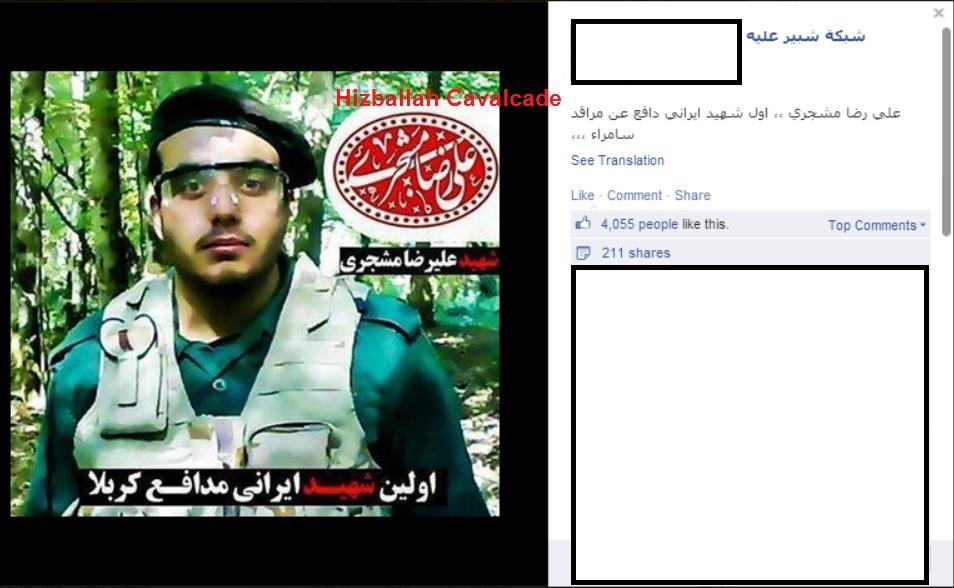
Figure 1: Post claiming the IRGC member was killed fighting in Samarra.
According to Iranian media outlets Ali Reza Moshajari, a member of Iran’s Islamic Revolutionary Guard Corps (IRGC), was reportedly killed in an accident on June 14, 2014.1 In another article written by the IRGC-linked Tasnim News, Moshajari was killed in “Western Iran” while on “a mission.” In all of the articles he is described as a “martyr” or “hero martyr.” However, his death was not such an open and shut case. In fact, Moshajari’s death may be further evidence of direct IRGC presence in Iraq.
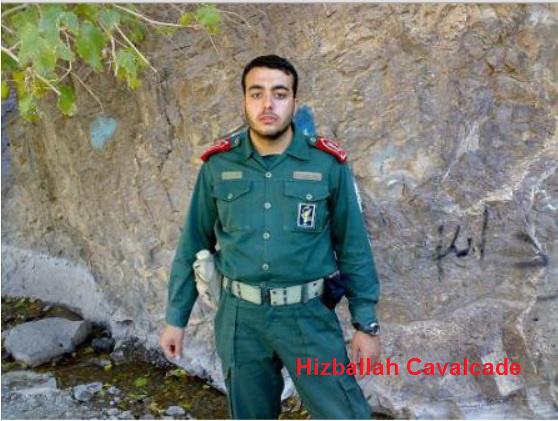
Figure 2: Moshajari in his IRGC uniform.
Before official announcements were made by groups such as Kata’ib Hizballah or Lebanese Hizballah stating they were both involved in fighting in Syria, both organizations would give vague explanations for the funerals of their members. The former would claim members had died due to illness or for other non-combat related reasons. Lebanese Hizballah would often only state that their fallen fighter had been “killed doing his jihadist duty.” Nevertheless, on social media run by many of these elements, it would be stated that the fallen fighters had in fact been killed in Syria. This may be the same type of structured announcement.
In some ways, this mirrors the announcements for the fallen IRGC member who was not only listed as a martyr for battle on a mission of some sort, but had competing accounts for how and where he died.
On Iran’s Islamic Revolutionary Guard Corps-linked (often these pages are run directly by the IRGC for internal and narrative purposes) social media networks–which run the gambit from Twitter and Facebook to Google Plus and YouTube—have cast Moshajari as an IRGC fighter who had been “martyred” in the IRGC deployment to Iraq.
It is possible that Moshajari was actually killed in an accident while deploying with IRGC units to sections of Iraq bordering Iran. CNN reported that 500 IRGC had been deployed to Diyala, an Iraqi province on the border with Iran.2 In Diyala Province, Kata’ib Hizballah and other Iraqi Shia Islamist groups backed by Iran have also reported being engaged in combat against units belonging to the Islamic State of Iraq and al-Sham (ISIS).
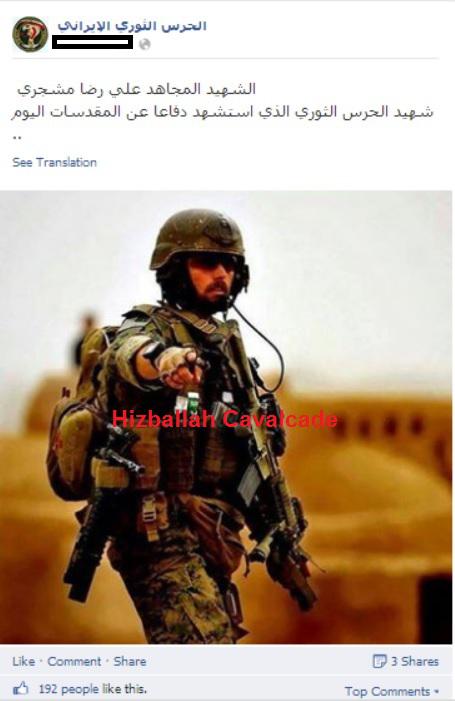
Figure 3: An IRGC Facebook page claiming Moshajari was the first IRGC martyr in Iraq while defending the shrines.
However, other Facebook-based sites with links to Iran’s regional Shia Islamist proxies and the IRGC also claimed that he had been involved in the “defense of Samarra.” Samarra has been a city of heavily publicized deployments by Iran’s Shi’a Islamist proxies within Iraq, mainly due to the fact that the holy Askari Shrine is located in the city.
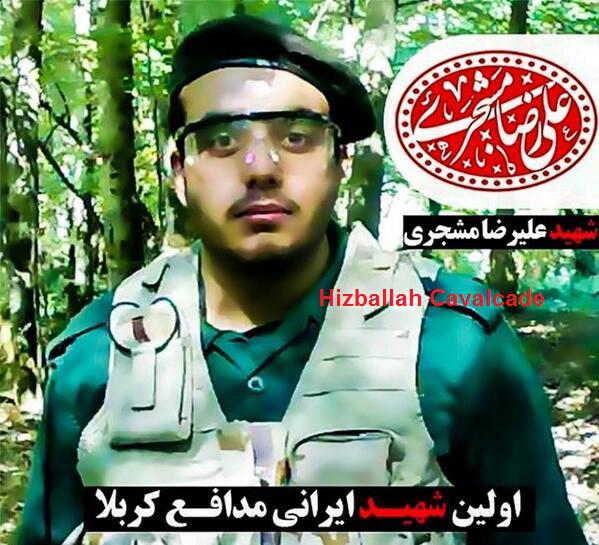
Figure 4: Killed IRGC member’s martyrdom poster. The poster was circulated primarily on Facebook and Twitter. It claims he was an “Iranian defender of Karbala.”

Figure 5: A photo of Moshajari’s face prior to his funeral.
_________
NOTES:
Happy Birthday Hizballah Cavalcade
NOTE: For prior parts in the Hizballah Cavalcade series you can view an archive of it all here.
—
Happy Birthday Hizballah Cavalcade
By Phillip Smyth
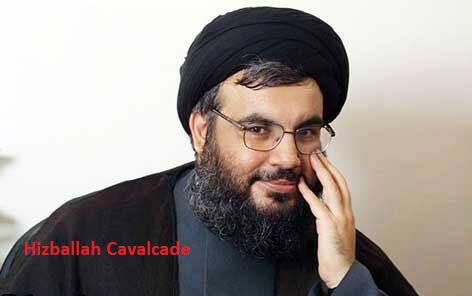
“All of the various fronts must unite. The organization must form an alliance; it must be a religious party…Everyone must unite in the Party of God, “Hizballah”. Everyone must speak out together. Everyone must rise up together.” – Grand Ayatollah Khomeini, May 13, 1978, speaking in Najaf, Iraq, in response to crackdowns by the Shah of Iran.1
It was a warm evening in early May 2013 when I met-up with a group of friends which included Aaron Zelin, the creator of Jihadology.net. We discussed the possibility of a guest post or me being able to assist with a section dealing with Shi’a jihadism. Since April of that year, I had been posting information on Lebanese Hizballah and other Iraqi Shi’a Islamist groups sending fighters to Syria on Twitter with the hashtag #HizballahCavalcade. We both felt this could be expanded and Aaron gave me the opportunity to put together some posts for the page. Who would have figured it would have grown and changed so much over the past 12 months?
Initially, I thought Hizballah Cavalcade would simply be an “attempt to display available photos of all funerals and martyrdom posters belonging to Shia groups which are fighting in Syria. In addition, funeral, combat, and even music videos belonging to these groups pertaining to the fighting in Syria will also be posted.” At the time, funerals and the imagery associated with them were the main way to gauge involvement. It was also unknown how deep the involvement of Shia Islamist fighters would be in Syria.
As I started to do more research, put together methodologies (which have grown and changed over the year), and truly devoted a higher-level of focus on more networks—particularly those on social media, it became clear that there would be plenty to post about for the page. As the information grew and the situation continued to transform, it became clear that putting “martyrdom announcements” or the funeral videos were simply not enough. Instead, harder analysis, focused on deeper studying of the material(s) and explanation was required with less “data-dump” style posts. As a result, Hizballah Cavalcade grew into a venue where I could put together posts on new organizations, links between the groups, their commanders, weapons systems, camouflage, where they were fighting, the fighters, uploaded combat videos, even the symbolism and language used by these groups.
Syria was also supposed to be the main focus for HC. In most respects it still is, but due to the interconnectedness of many of the forces, it became necessary to expand the scope. Consequently, I started to also focus on where many of the Shia Islamist forces fighting in Syria had originated: Iraq. Narrative development also became increasingly important as it became necessary to explain key elements regarding why a Shia jihad was occurring in Syria.
Recently, in March 2014, I started working on a subseries on Hizballah Cavalcade called “The Pearl and the Molotov” which sought to explain the growing numbers of militant Shia jihadi groups in Bahrain. I had expected to put up around five posts and focus back on Syria. However, the growth, narratives, and importance of the development has yet to stop. The hope for the rest of 2014 (and hopefully 2015) is to continue to offer some other subseries on geographic areas where there is also Shia jihadi activity.

Figure 1: I’m still searching for a correlation between Chichen Itza and fallen Shia Islamist fighters.
Hizballah Cavalcade also helped established something else which was far more expansive than simply being a niche series covering Shia Islamist organizations and their battles. The importance of open-source social media and internet-based platforms with this unique primary source information truly came to light. As the broader and at times (unfortunately) intellectually-rigid analytical community learns to deal with this 21st century reality, it is plain to see that the old narrative of, “Well, that’s just social media material” increasingly has little merit.2 As exemplified with a number of new Shia Islamist militias in Syria, their existence was announced to the world via a Facebook page. This neither means that social media sources are the best nor that they should not be used in conjunction with other sources, but their utility and the breadth of information they offer is a true game-changer.

Figure 2: Hizballah: the car seat.3

Figure 3: A young Hassan Nasrallah washing-up.
Praise & Coverage for Hizballah Cavalcade
Over the past year Hizballah Cavalcade has also gotten some fantastic coverage in the media. Needless to say, it always serves as an ego boost and affirms that the pieces are useful for those following complex situations involving Shia jihadist elements.
Noted Iraq expert Michael Knights, who also wrote a Washington Institute For Near East Policy piece on Shia Islamist fighters in Syria, used HC as a main reference and was kind enough to say HC had, “the best coverage of these issues.”
During the Battle of Qusayr, posted figures on HC of Lebanese Hizballah dead were cited by distinguished journalist Anne Barnard of the New York Times. Since then, Hizballah Cavalcade has been featured, quoted, and cited in pieces by a myriad of top journalists, blogs, newspapers, magazines, and other publications including (but not limited to): The Wall Street Journal, AFP, McClatchy, National Public Radio, Australian Broadcasting, NOW Lebanon, the Carnegie Endowment for International Peace, Foreign Policy, The Huffington Post, The New York Review of Books, USA Today, The Financial Times, and The Christian Science Monitor. Fitting with the maxim that, “80% of what is written has been written before” a number of other publications have recycled (without credit) HC posts into their own pieces.
Additionally, the posts on Hizballah Cavalcade gave me the opportunity to write longer pieces for Foreign Policy and West Point’s CTC Sentinel. There was also the privilege of being able to take part in an “Ask Me Anything” on Reddit. In November 2013 I had the great honor to testify in front of the U.S. House of Representatives regarding Shia Islamist groups fighting in Syria. When jihadism expert Daveed Gartenstein-Ross testified in front of the Senate Foreign Relations Committee he also gave praise to HC.
Based primarily on a Hizballah Cavalcade piece on the musical narrative of Shia militias in Syria, Aaron Zelin (who addressed Sunni jihadist anasheed) and I were featured in a Washington Post piece. Shia jihadi music has been a long standing and rather esoteric obsession of mine. The ability to post my analysis of this material and see the positive reactions to it is always wonderful.
Quotes and references aside, the private conversations I have with many well-informed and experienced followers of the region always present me and the blog with new insights. I am always happy to share what I have learned with them and others.
Thanks
I try to write pieces I would like to read and my greatest hope is that others find it informative, novel, and able to address specific trends. Not to sound cliché, but those who read my posts are both an inspiration for me and often serve as the push I need to continue writing. There are times when I suffer from a good bout of frustration from certain geopolitical conditions and the analysis which comes out of it. It’s very easy to jump down the ultra-cynical rabbit hole and either stop writing or produce subpar work. Nevertheless, Hizballah Cavalcade’s readers have time and time again challenged me, taught me new things, and most importantly demonstrated that they too wanted to read the material. To my many colleagues and friends, thank you for your kind words, suggestions, assistance, and the encouragement you all have given me.
I promise to continue to write more posts and I truly hope everyone has benefited from reading them.
Thank you all for reading Hizballah Cavalcade! Time to cut the cake.
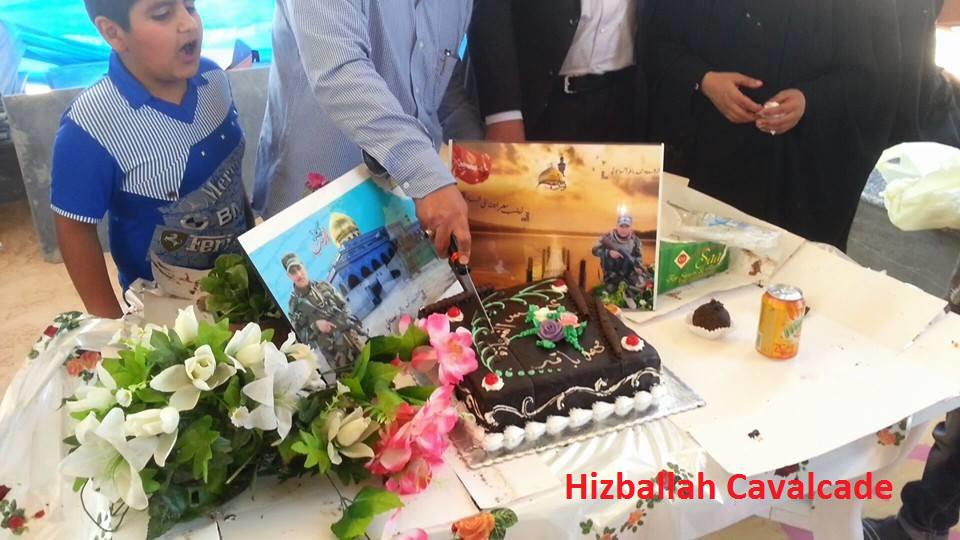
Figure 4: A Kata’ib Hizballah celebration for the martyrdom of one of its members in Syria. (Special thanks to an anonymous reader who sent the photo).
__________________
